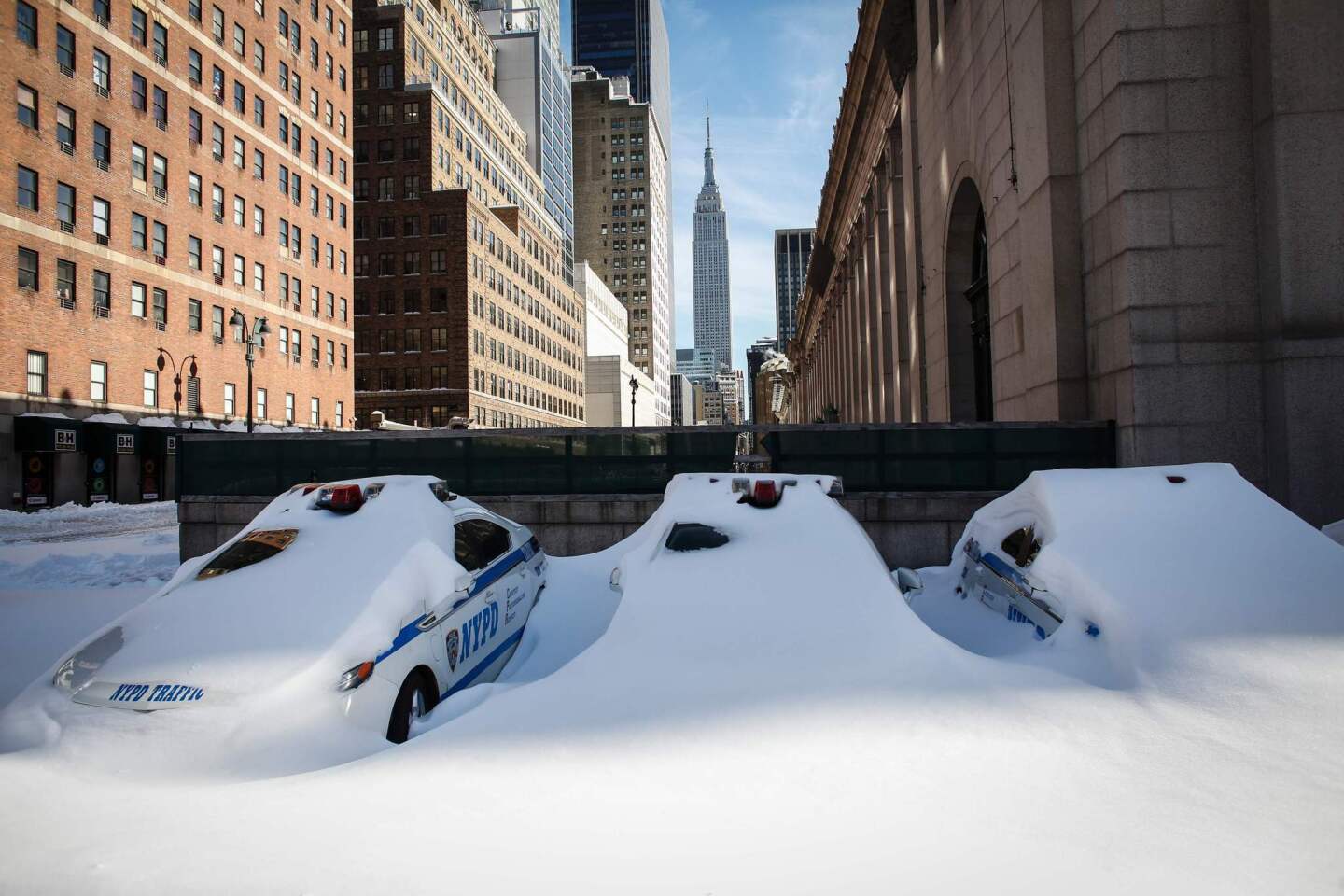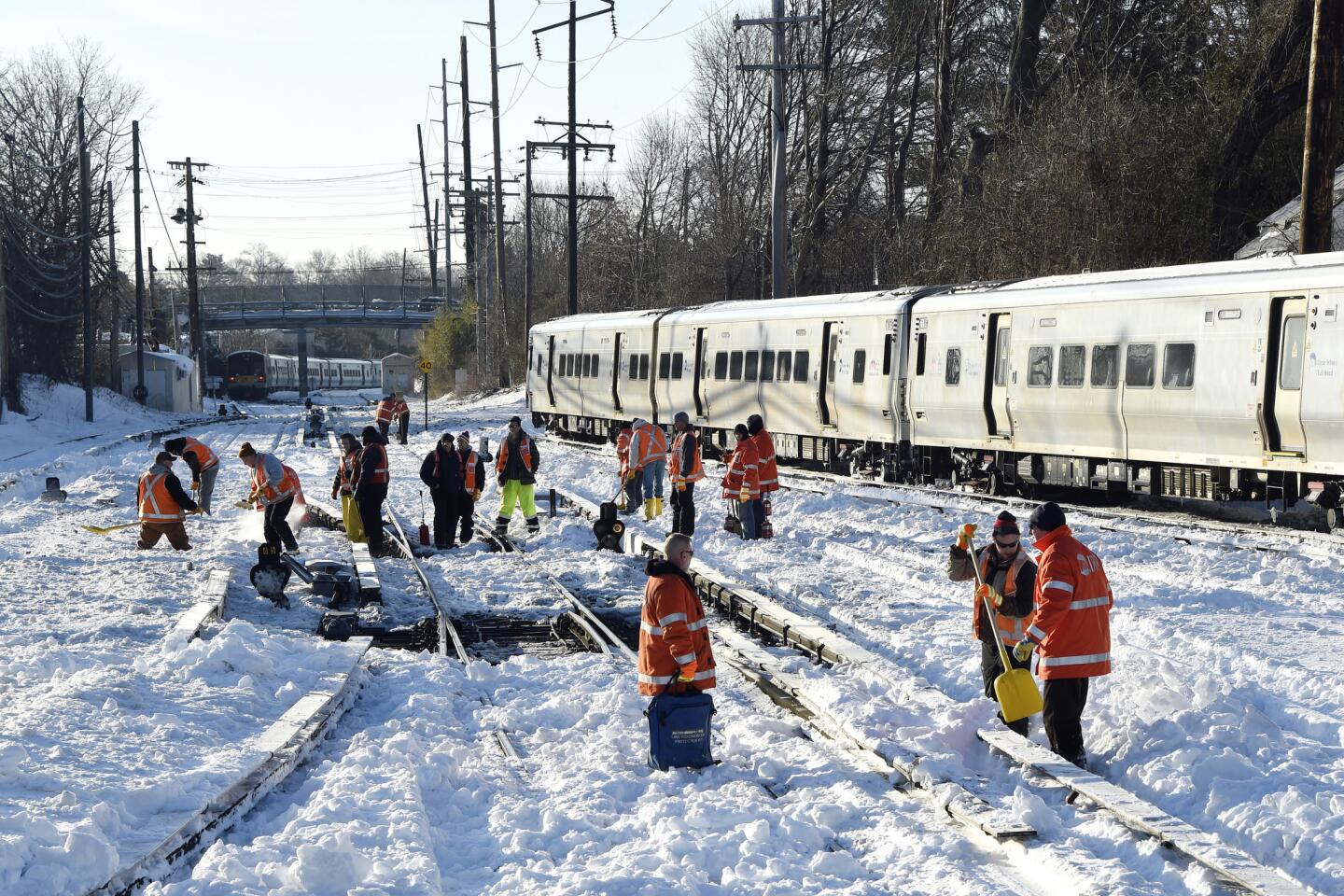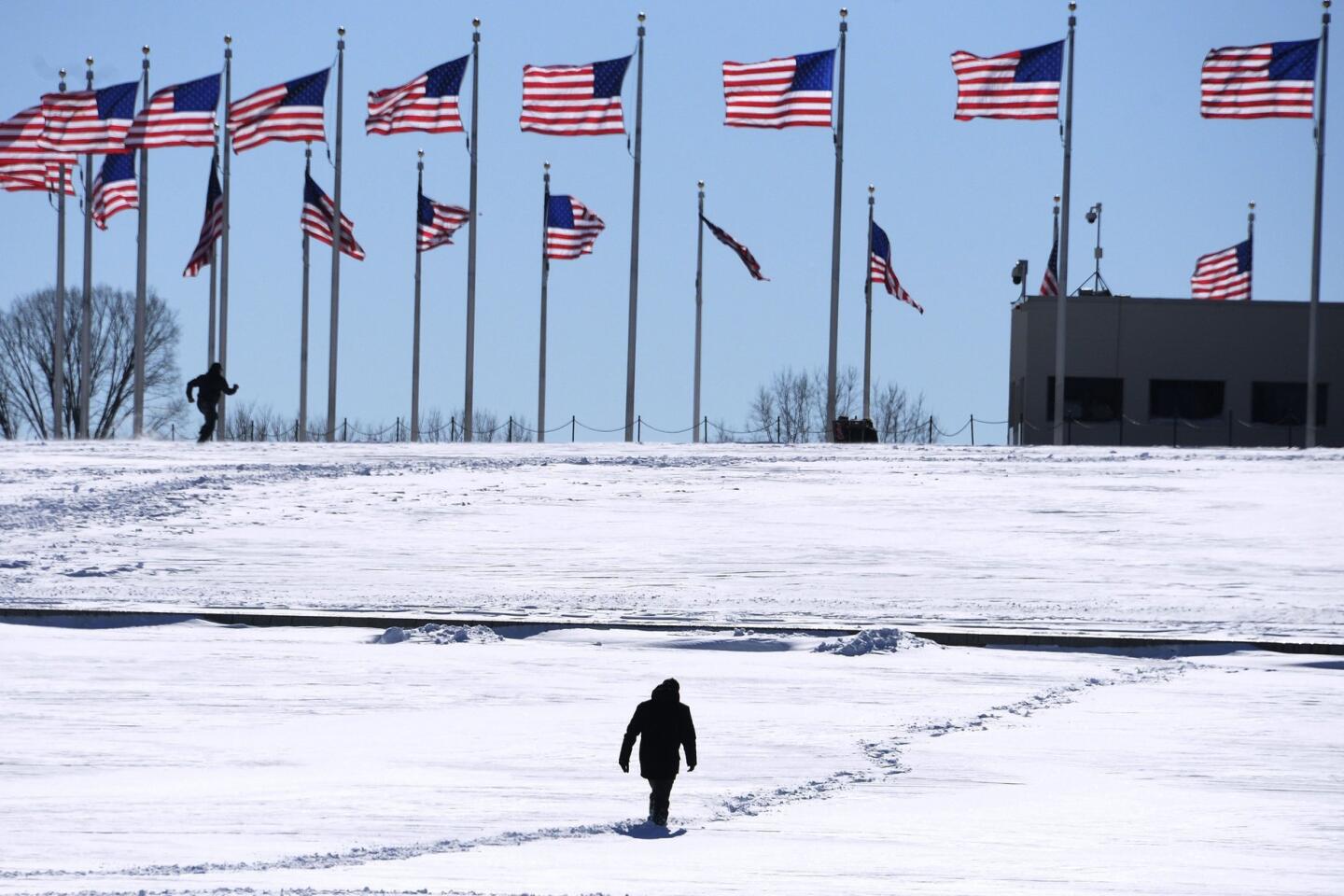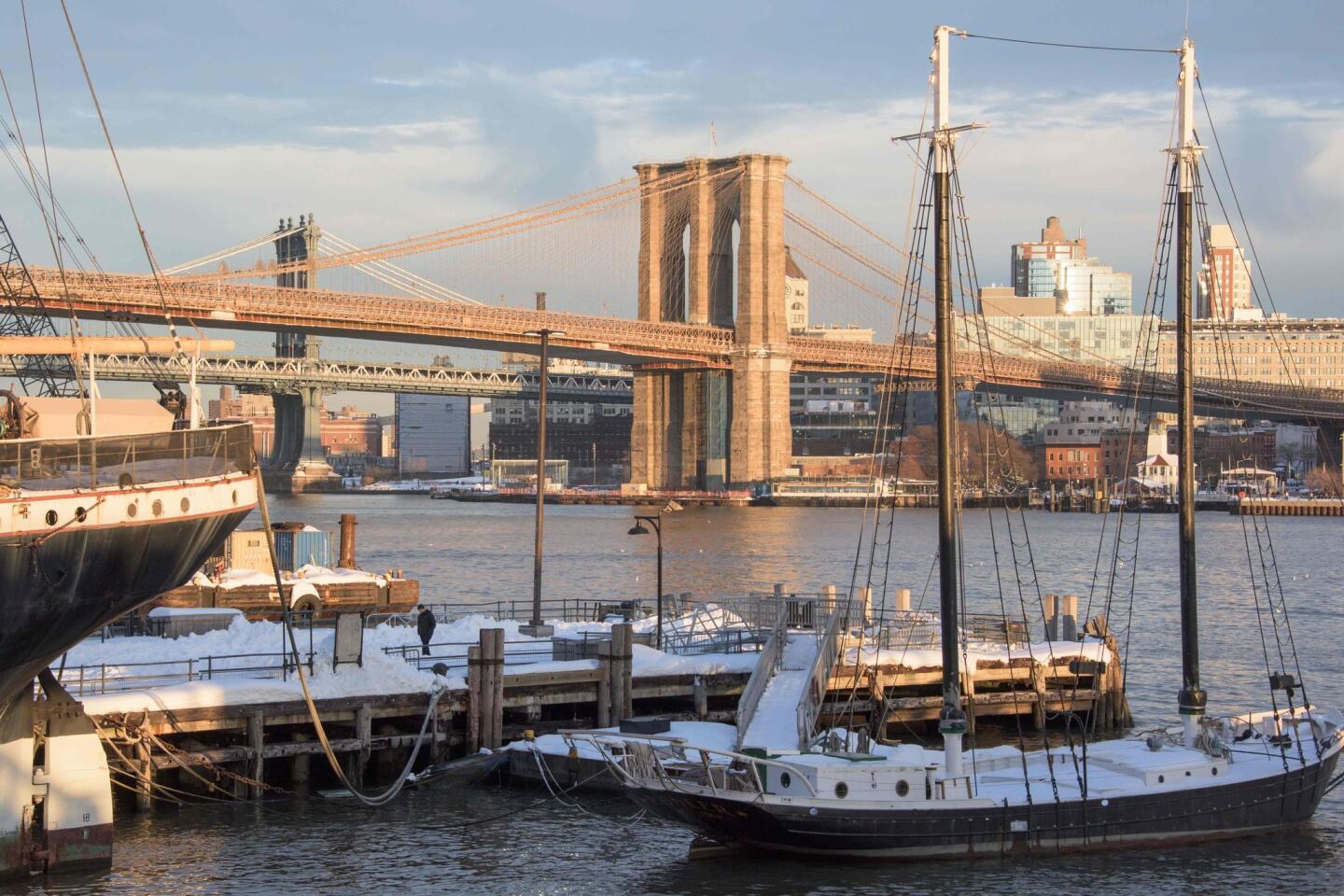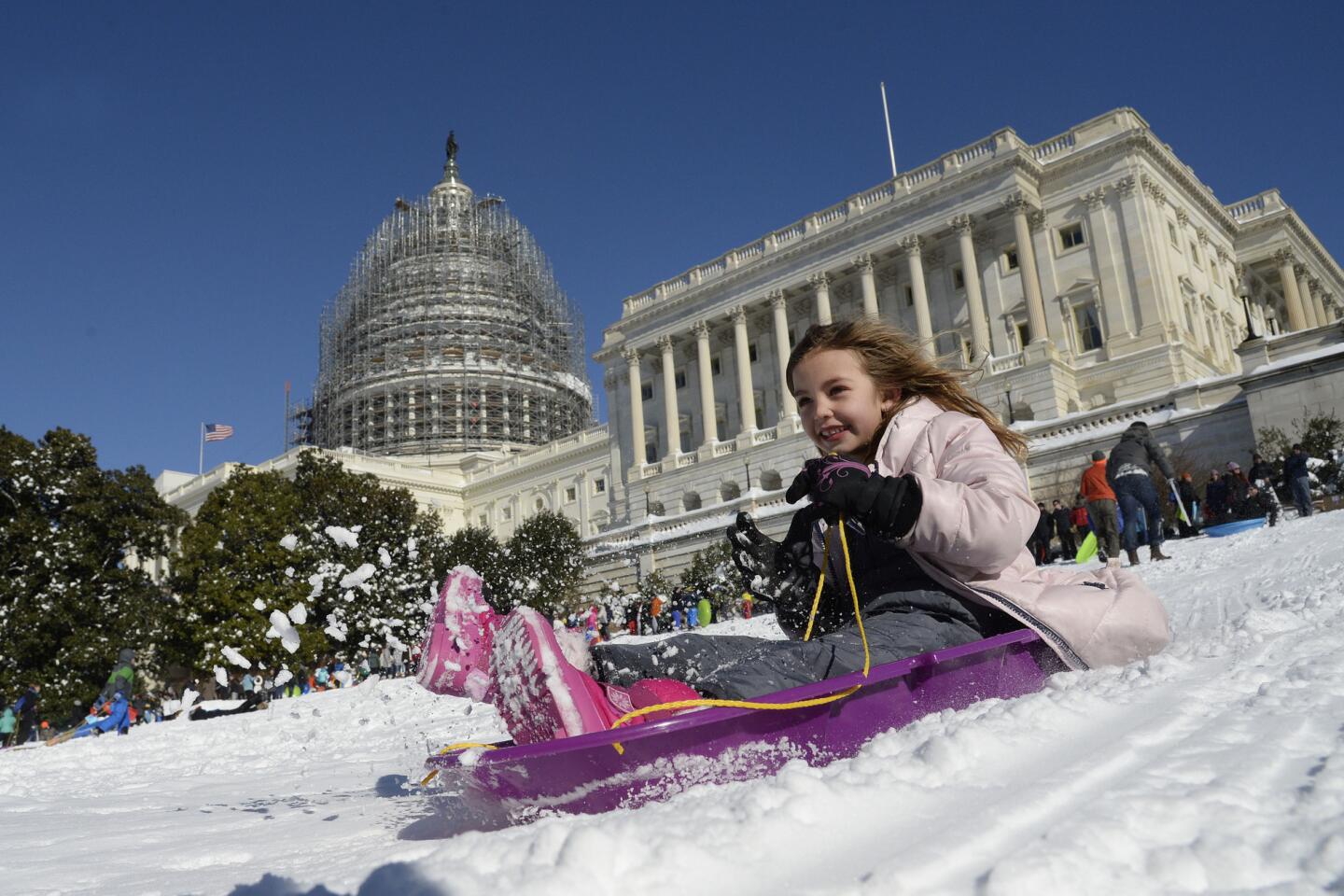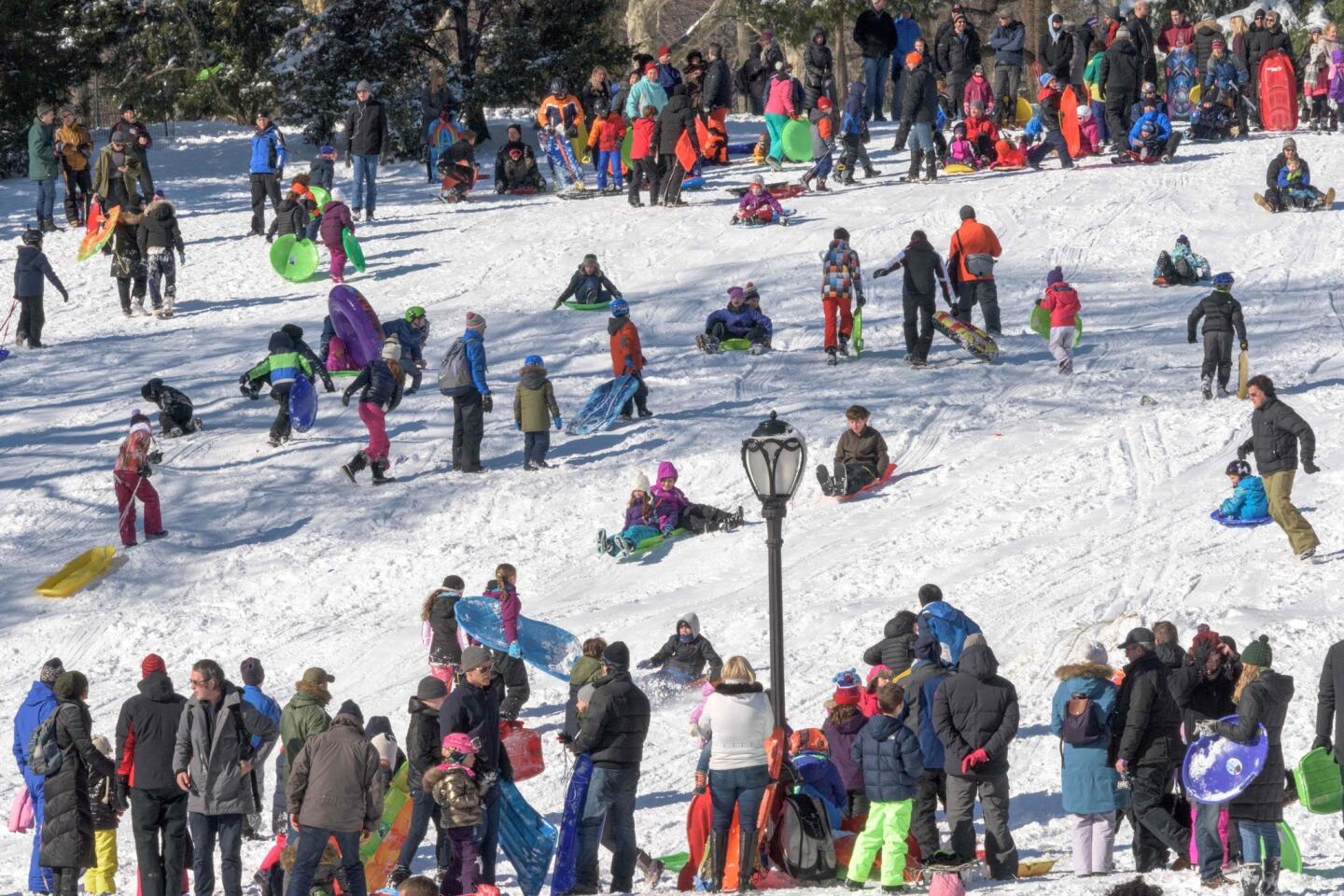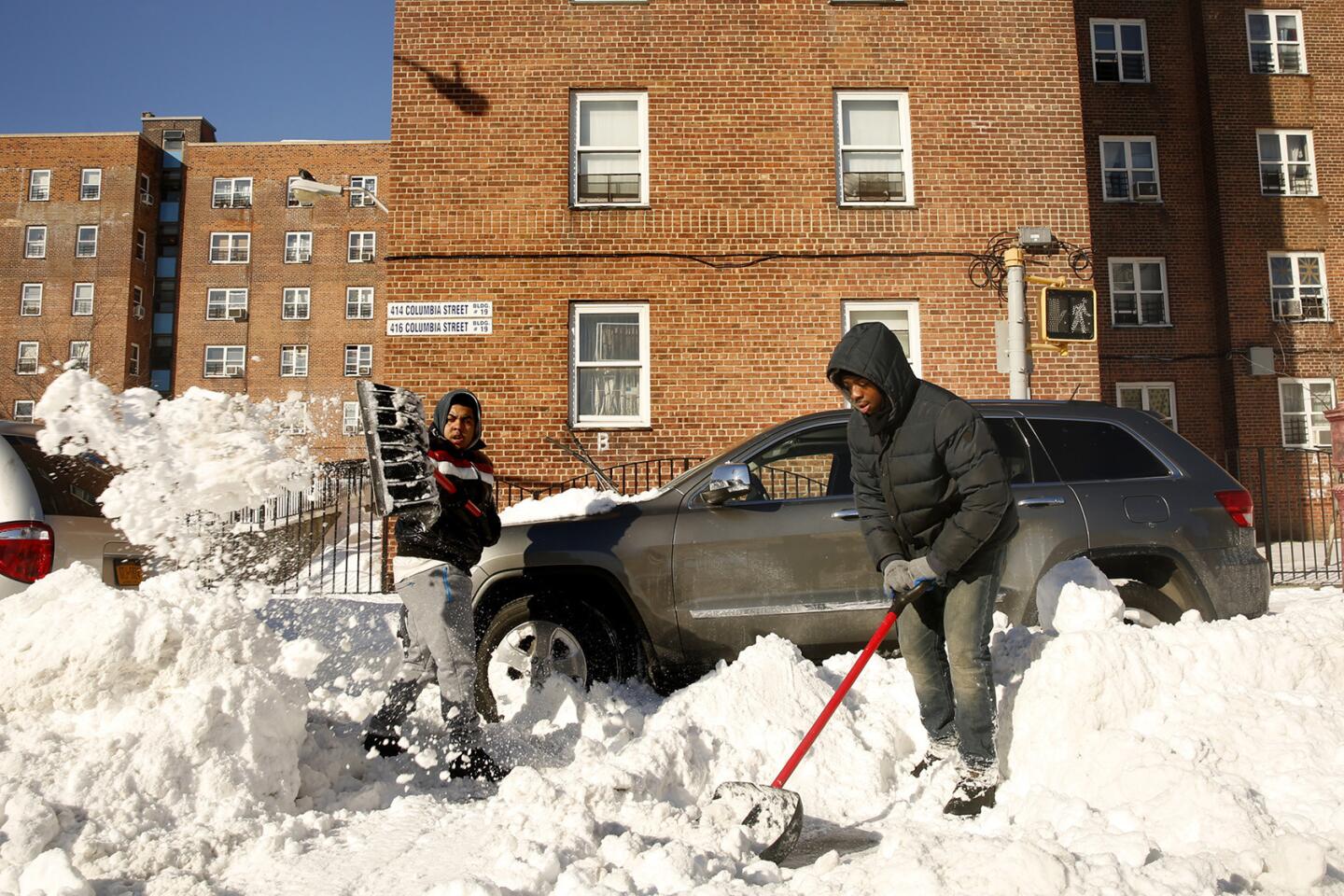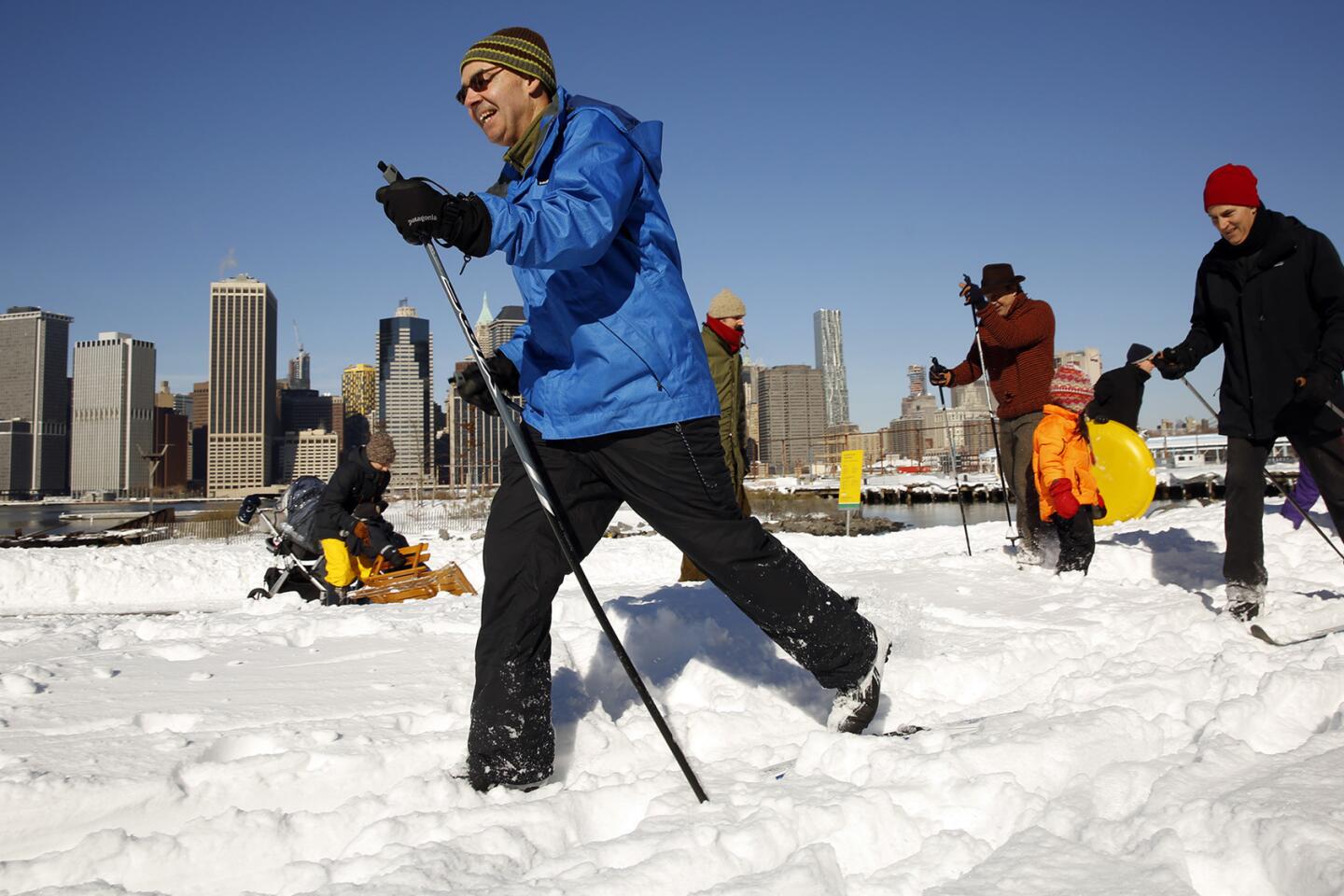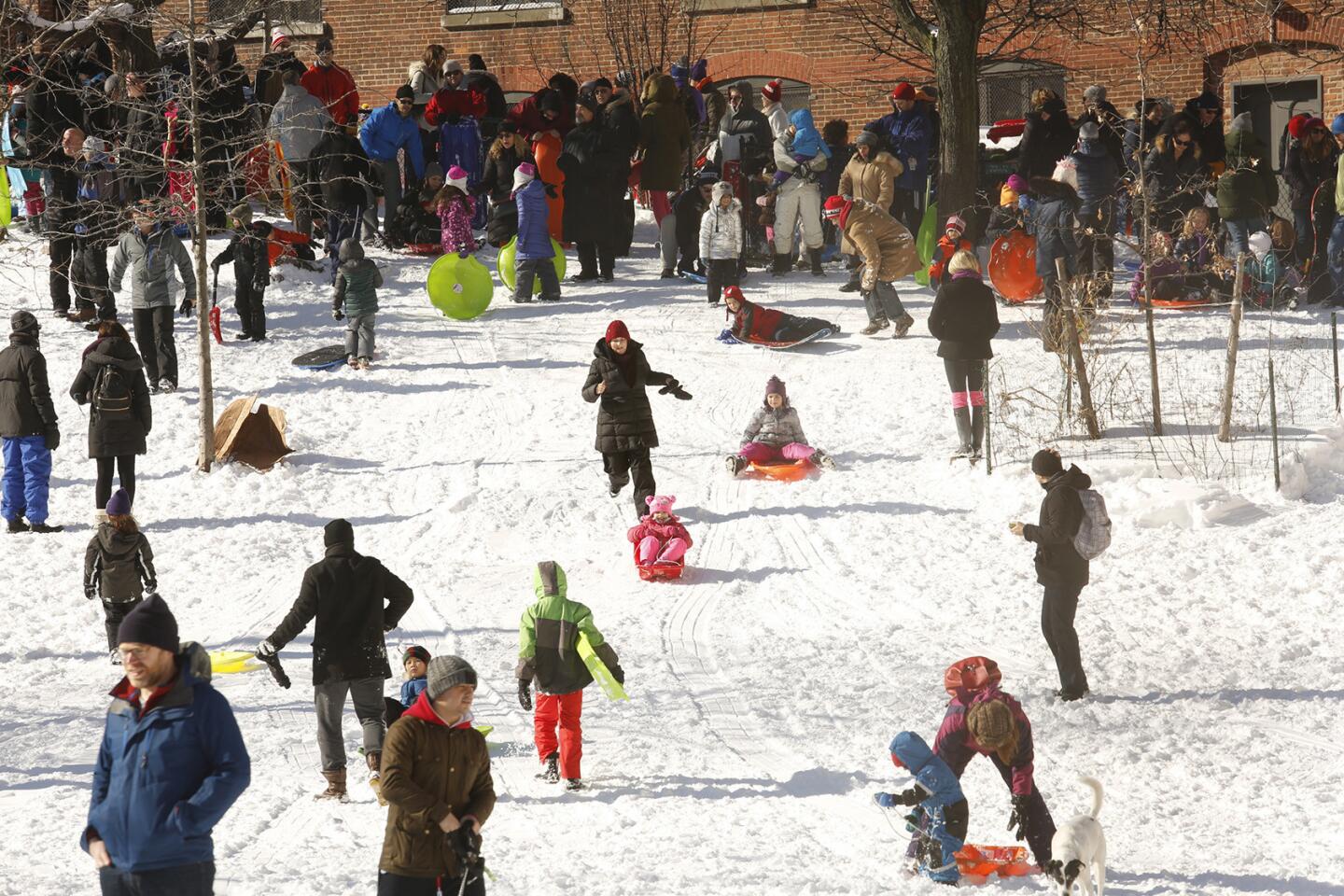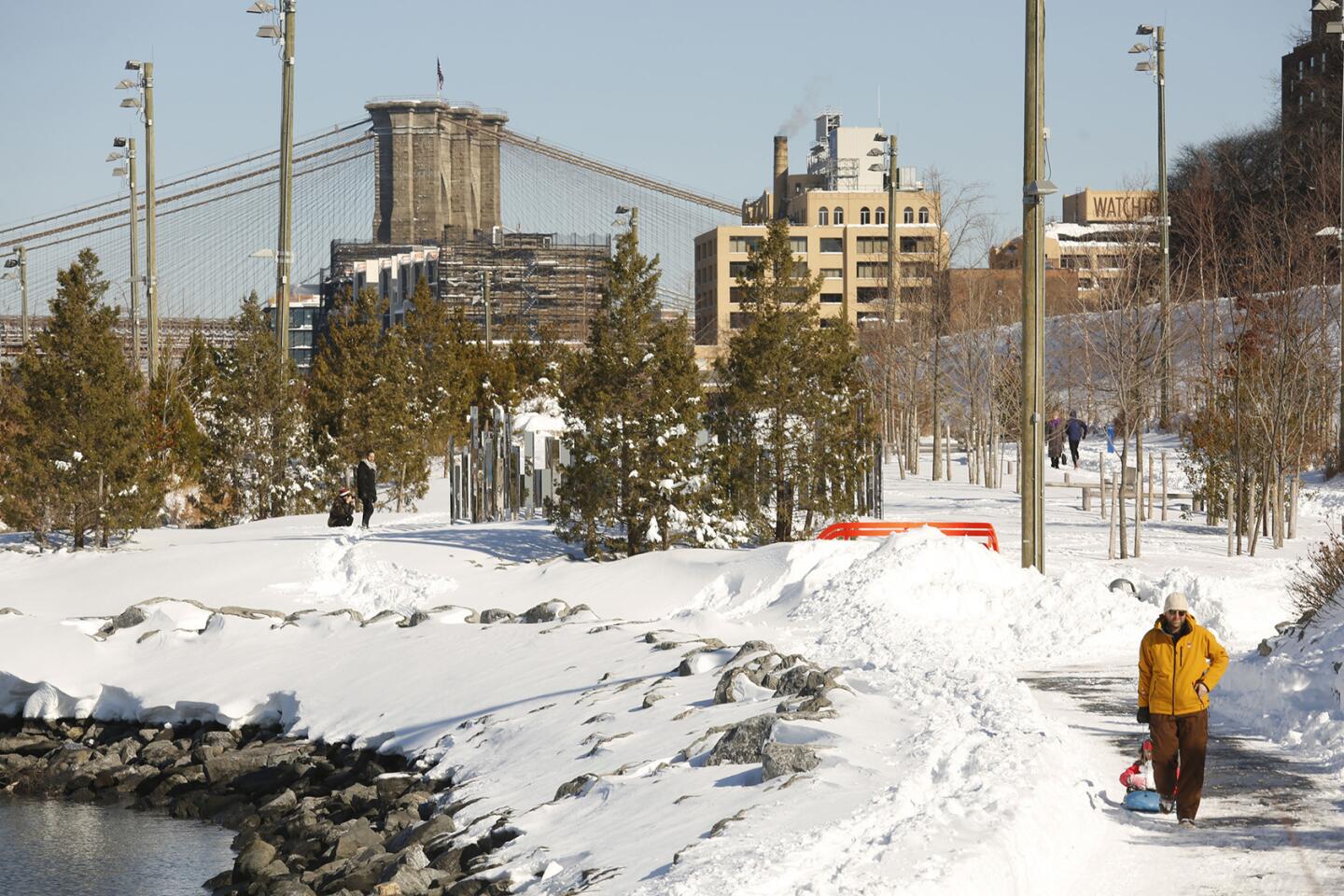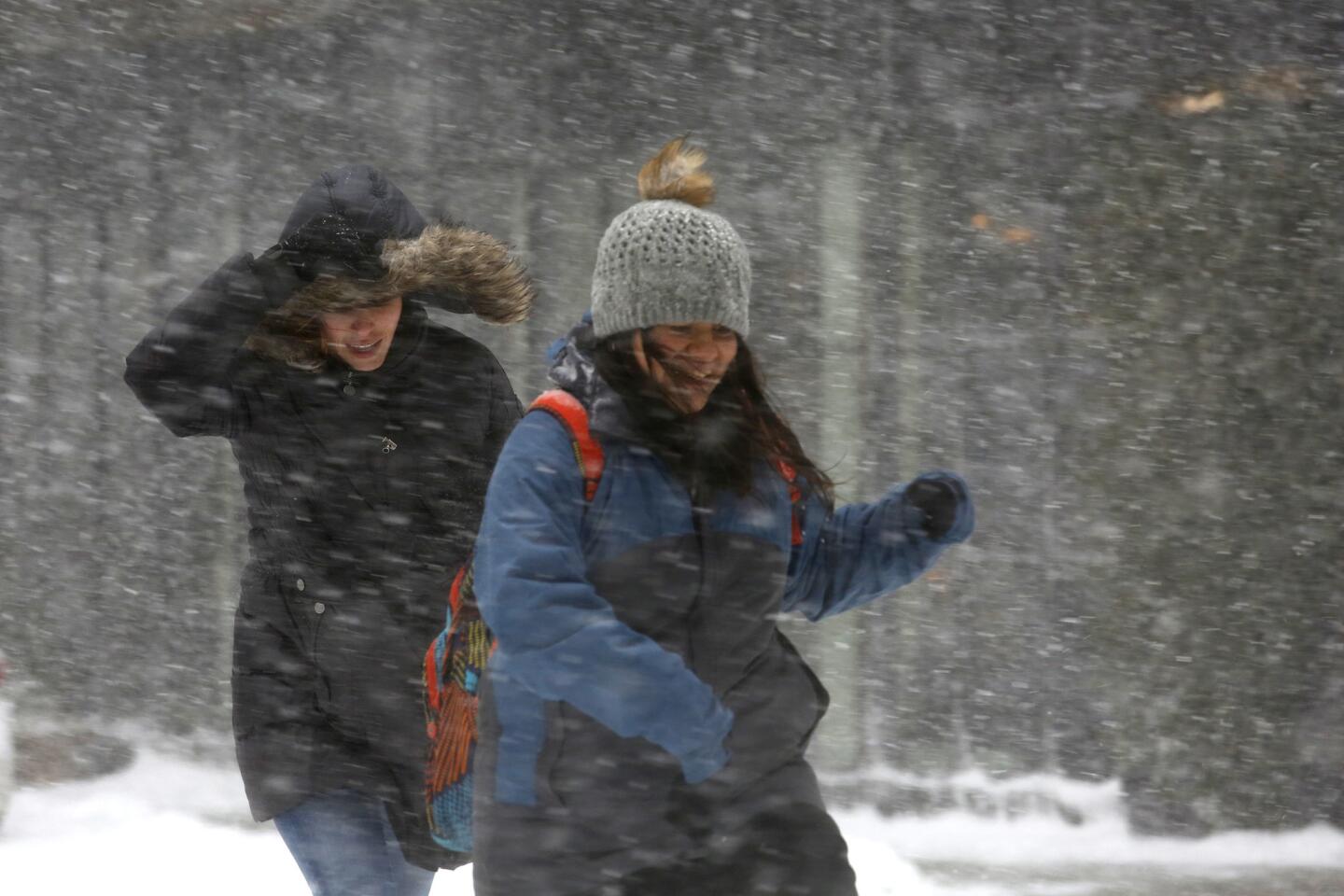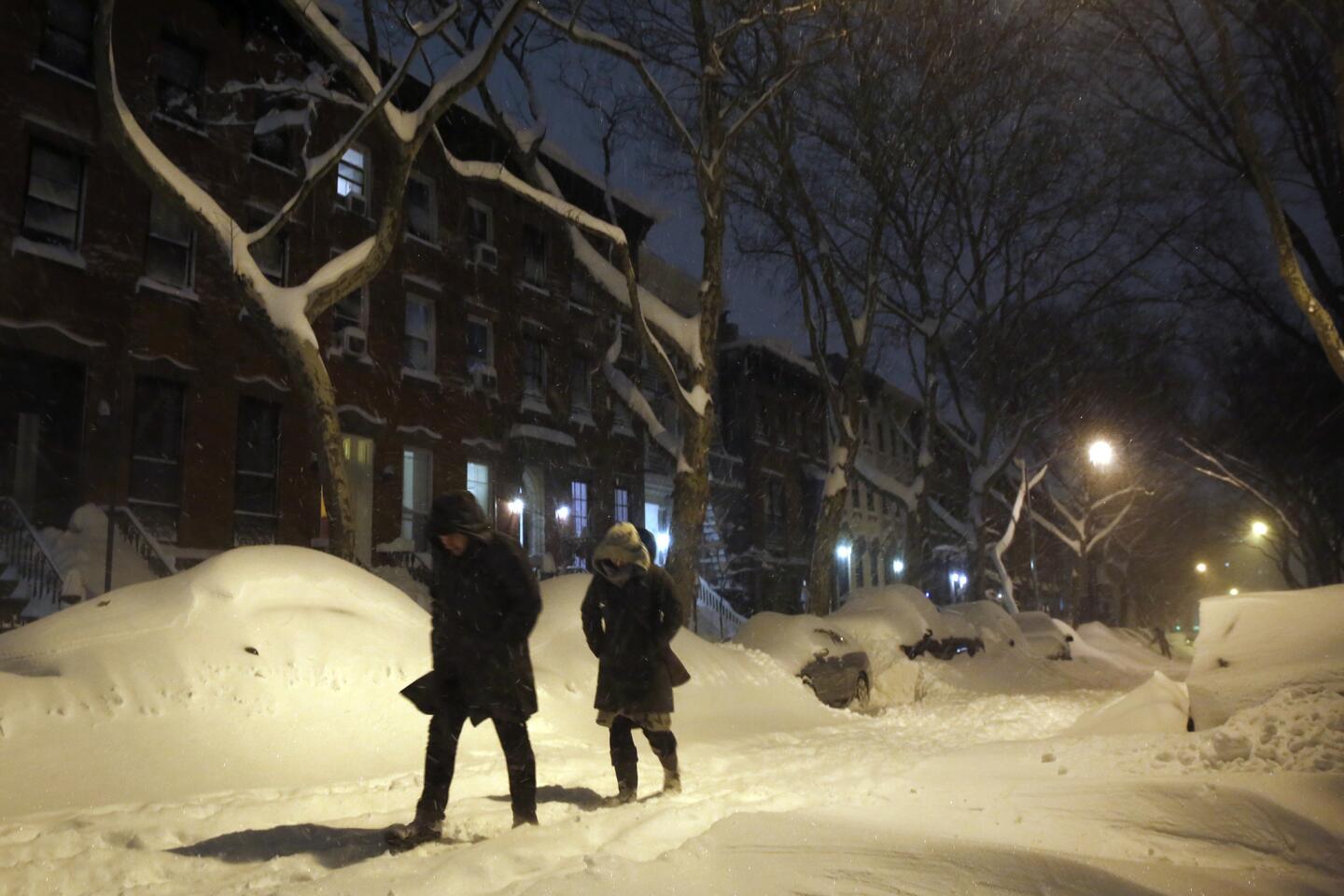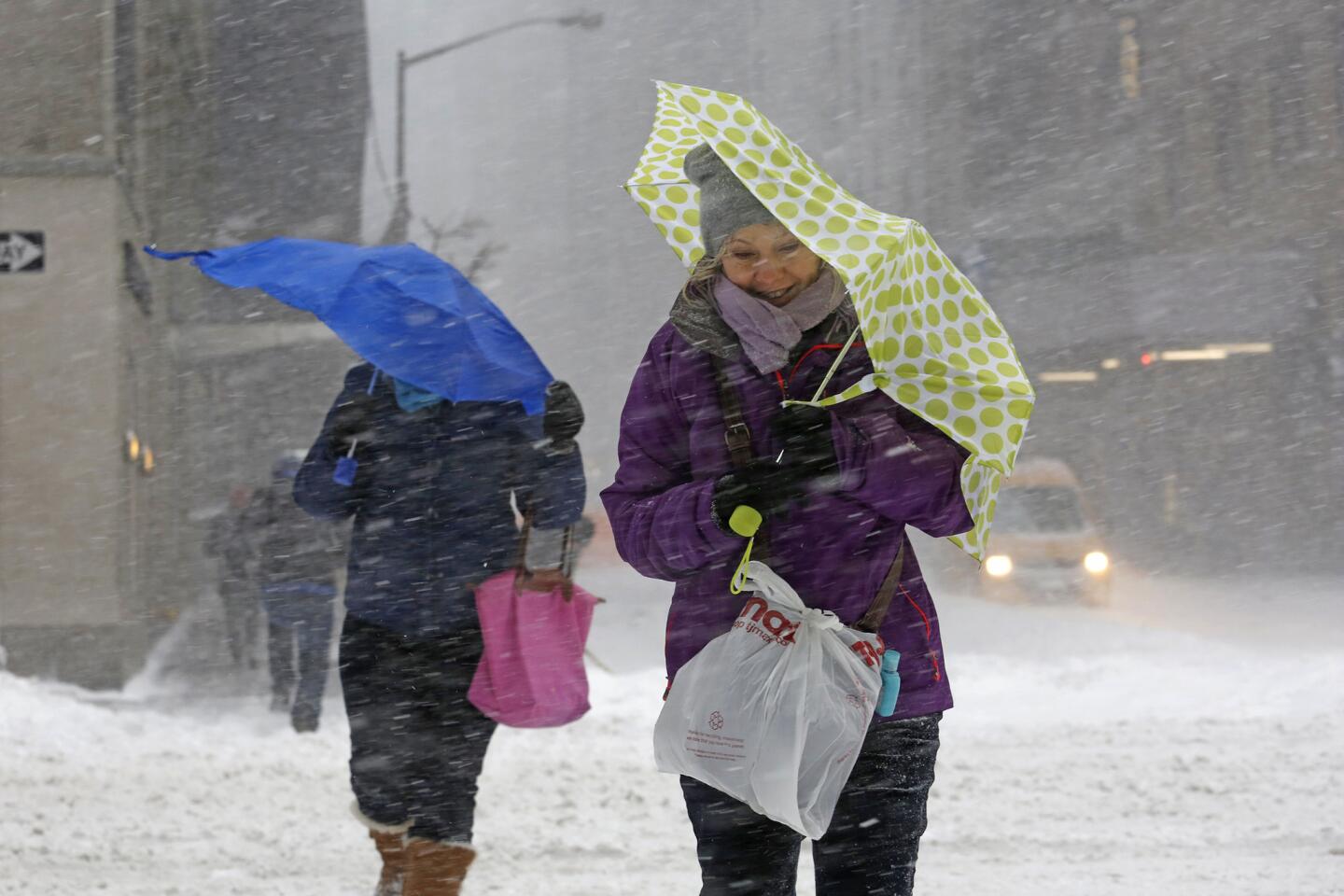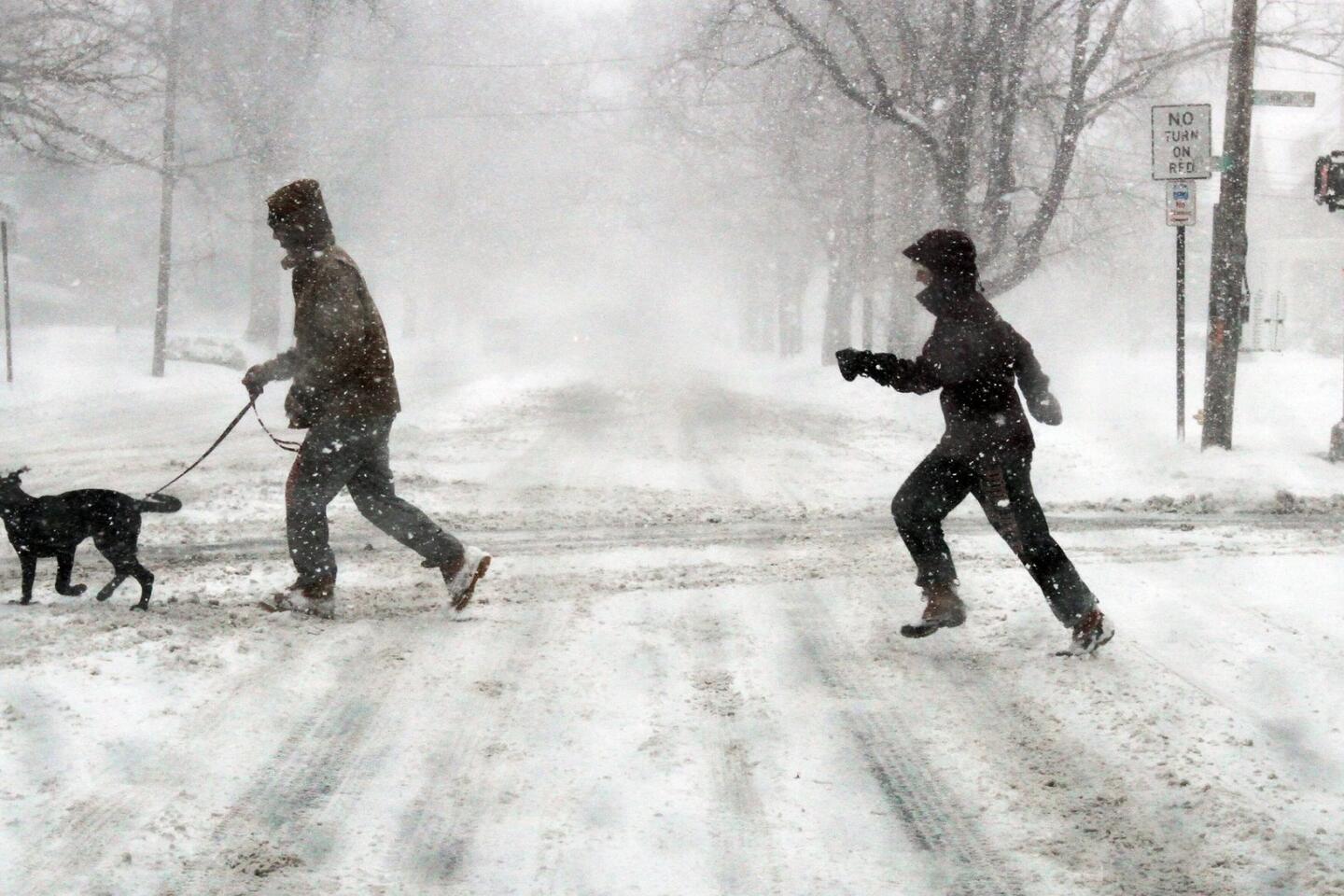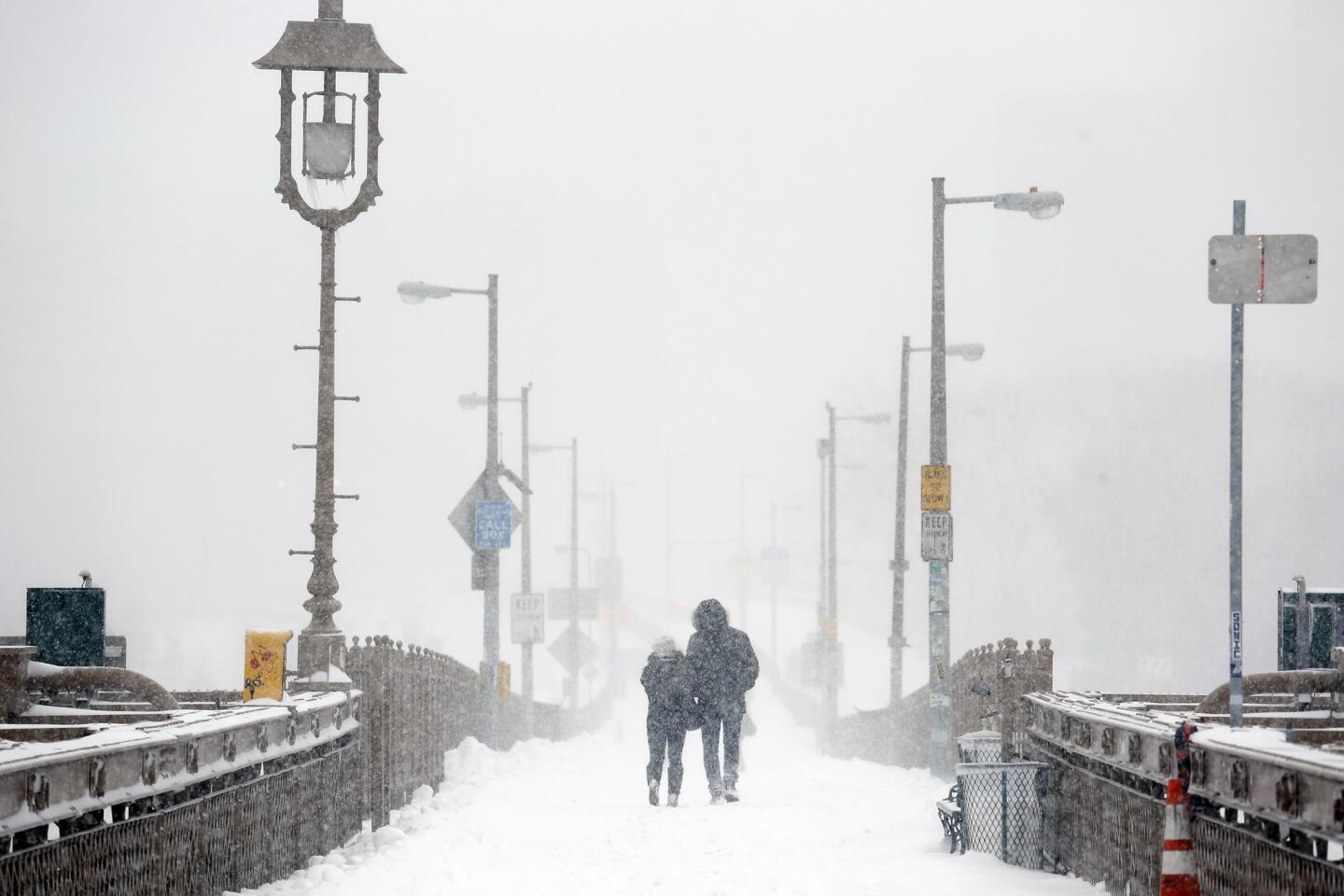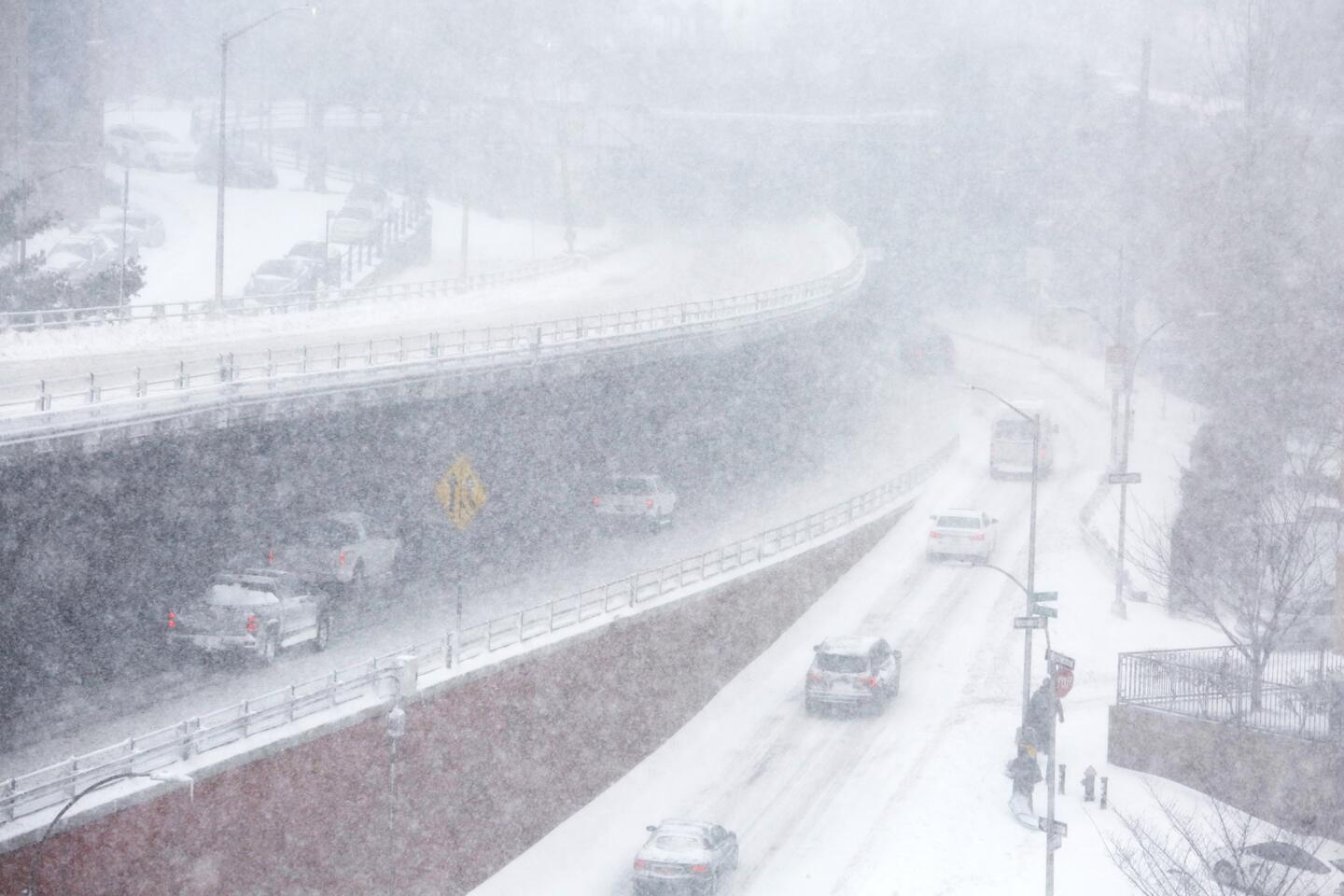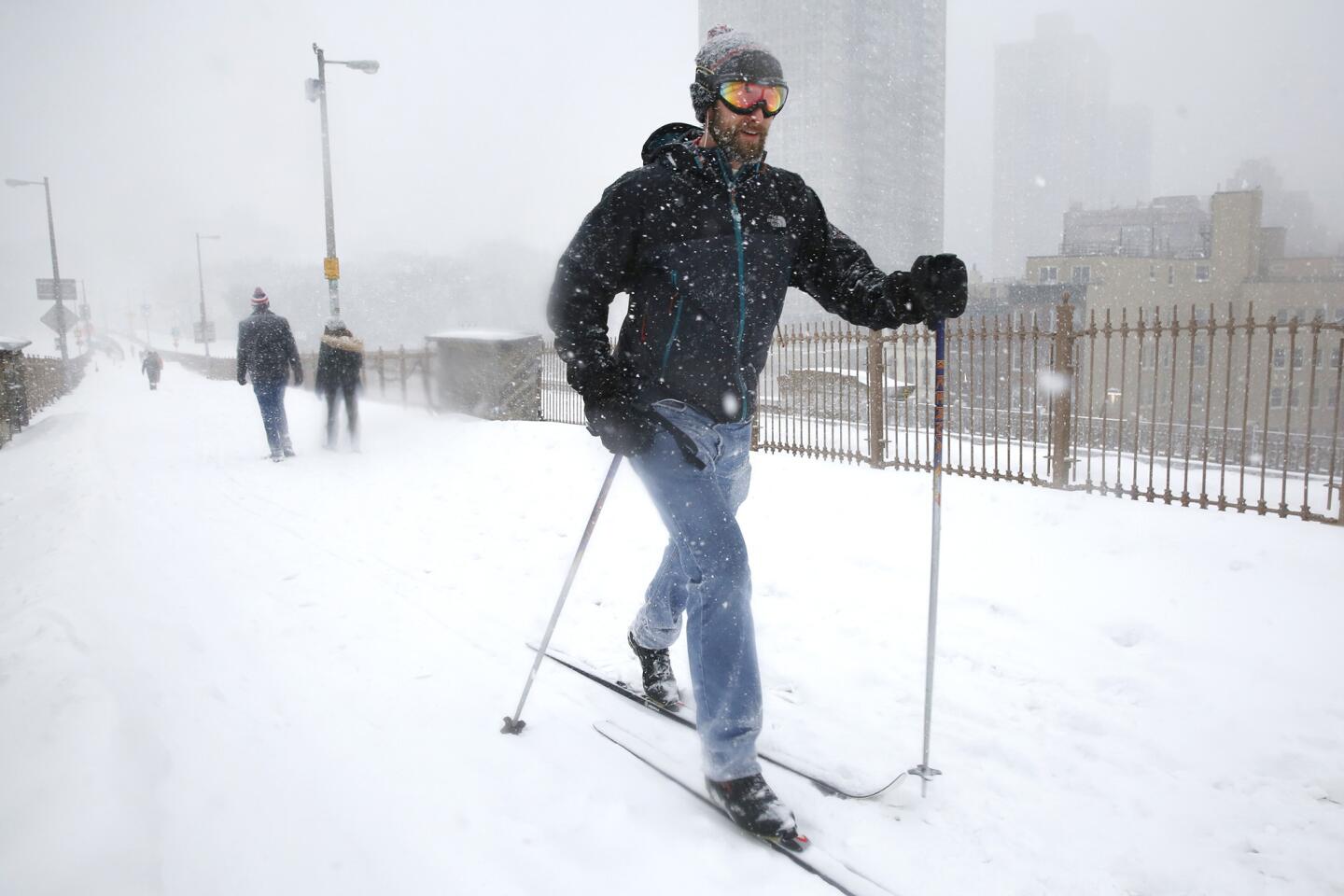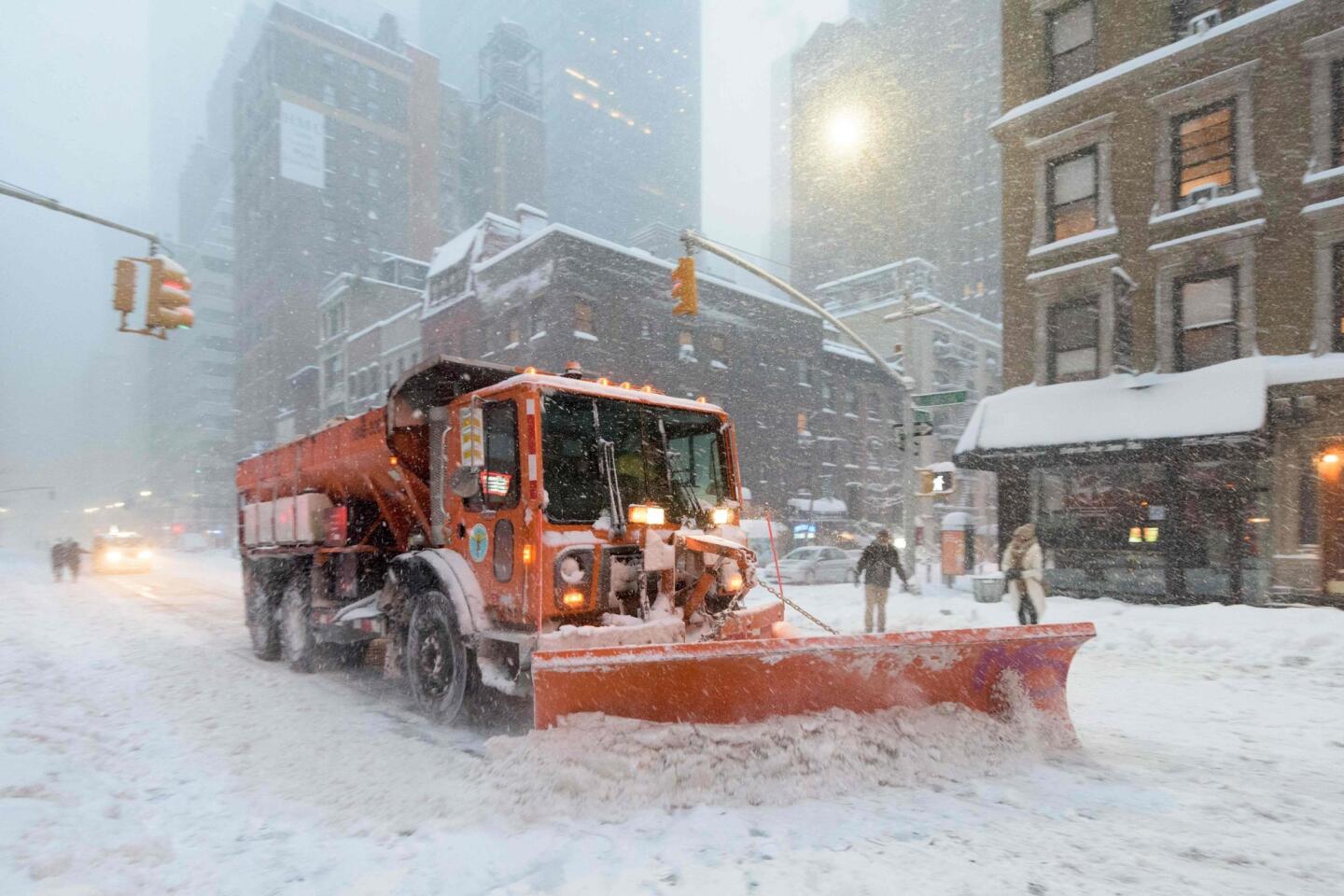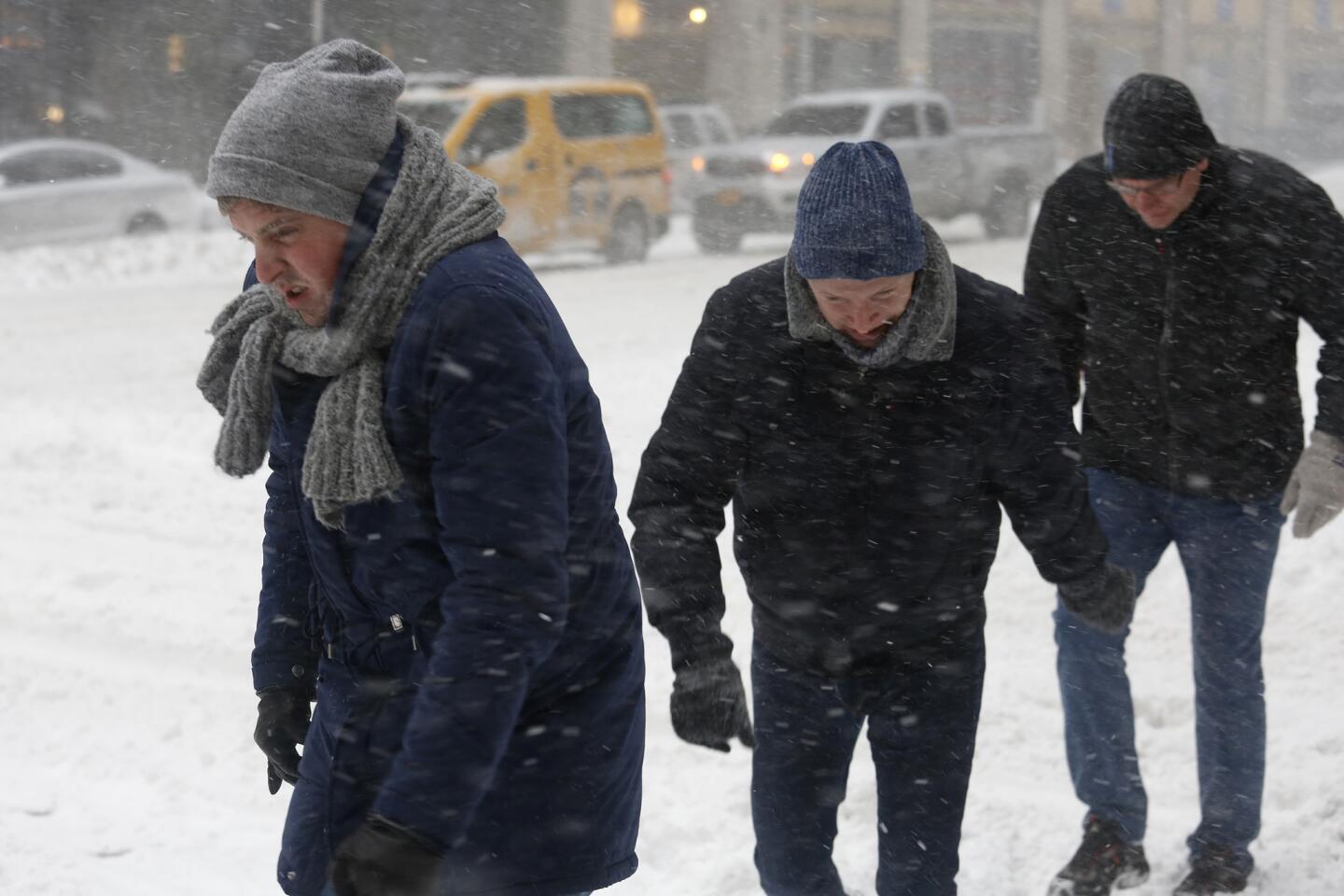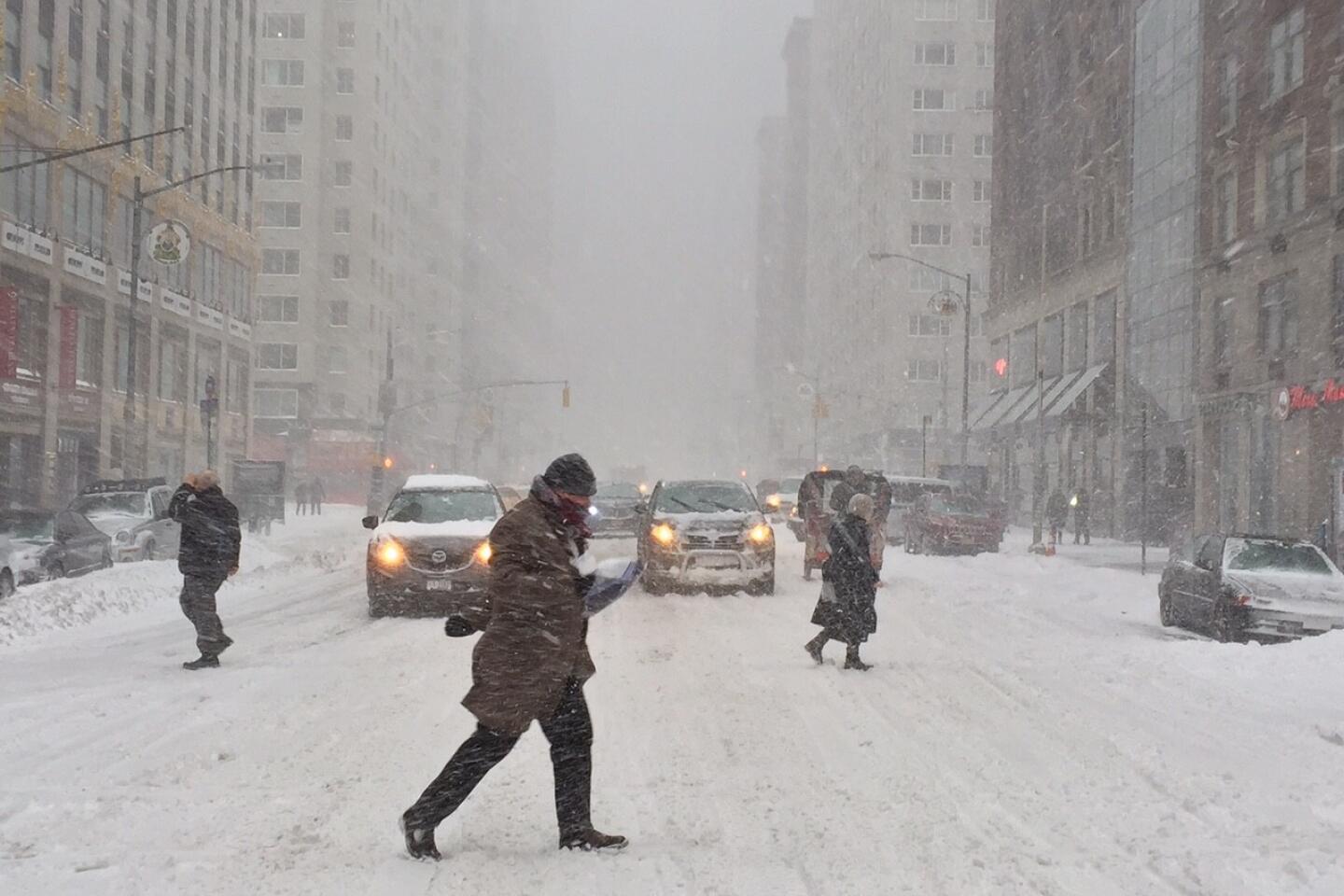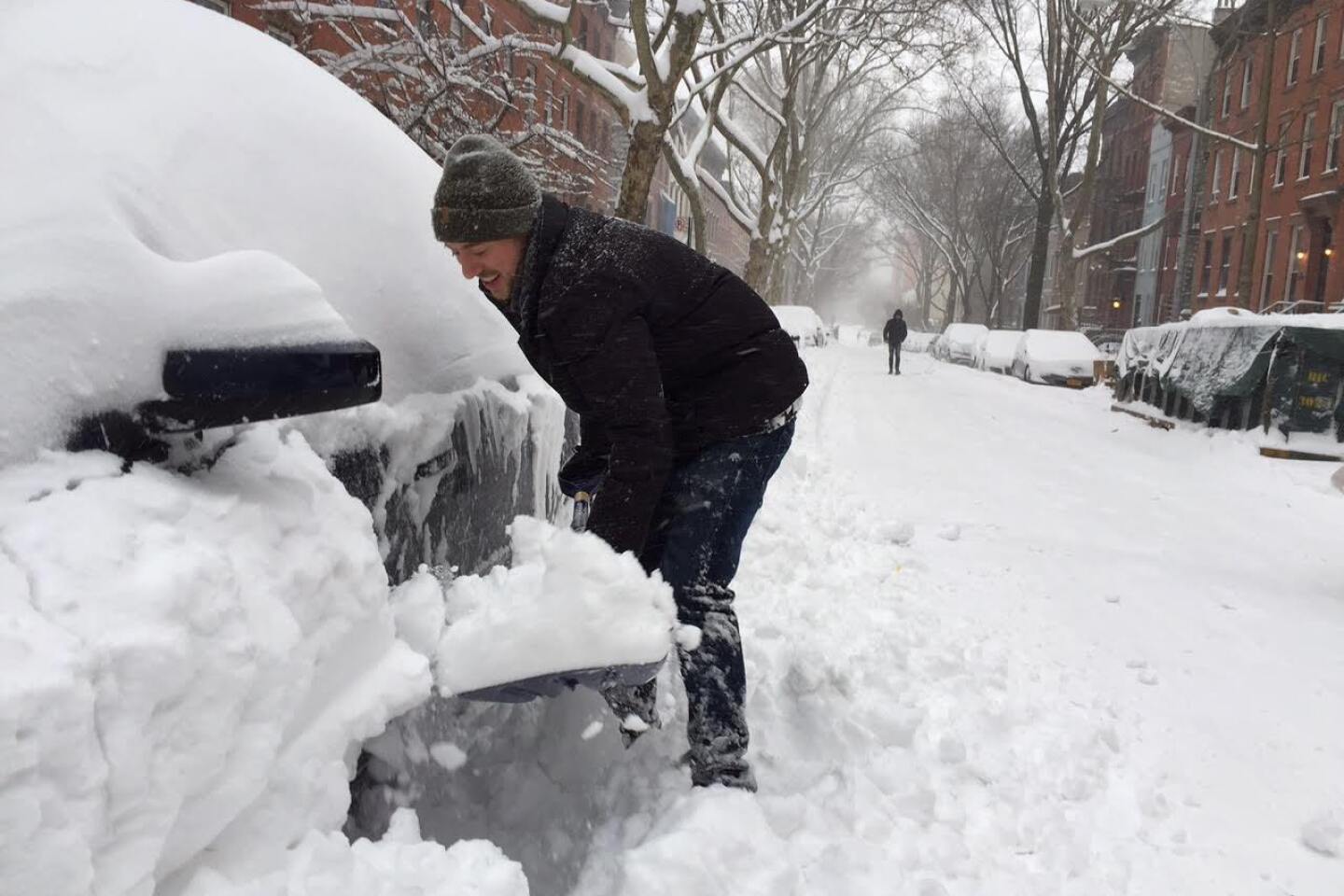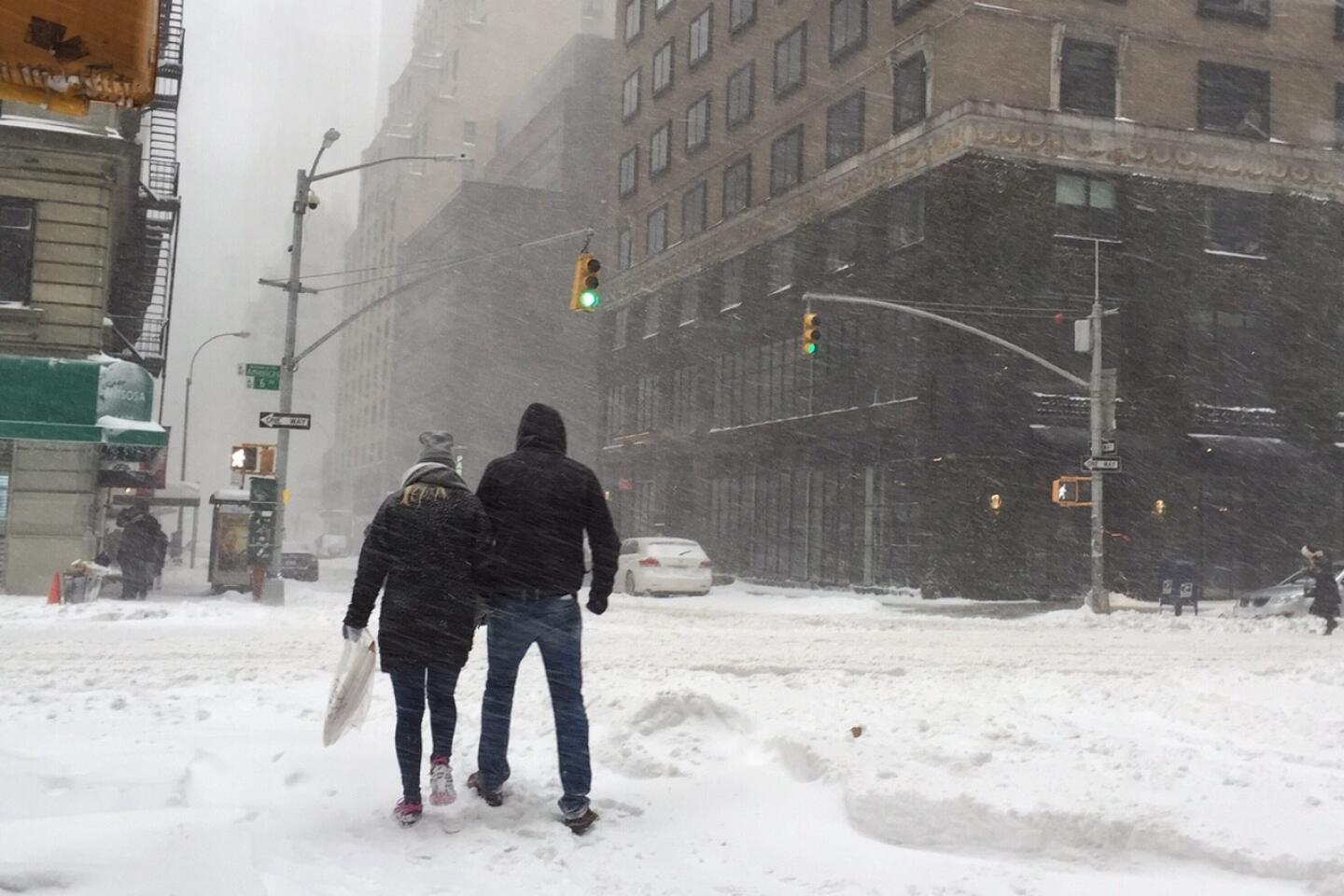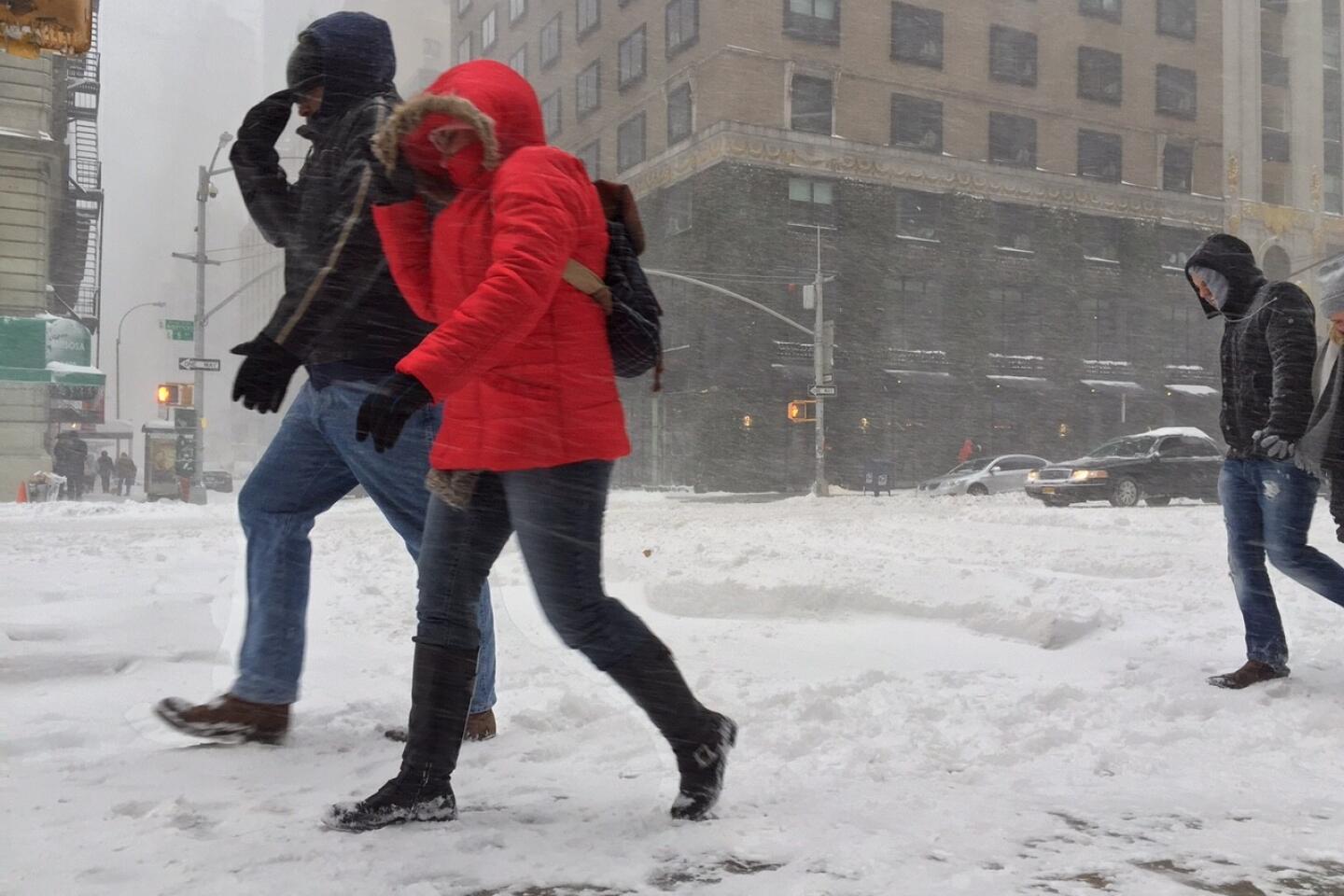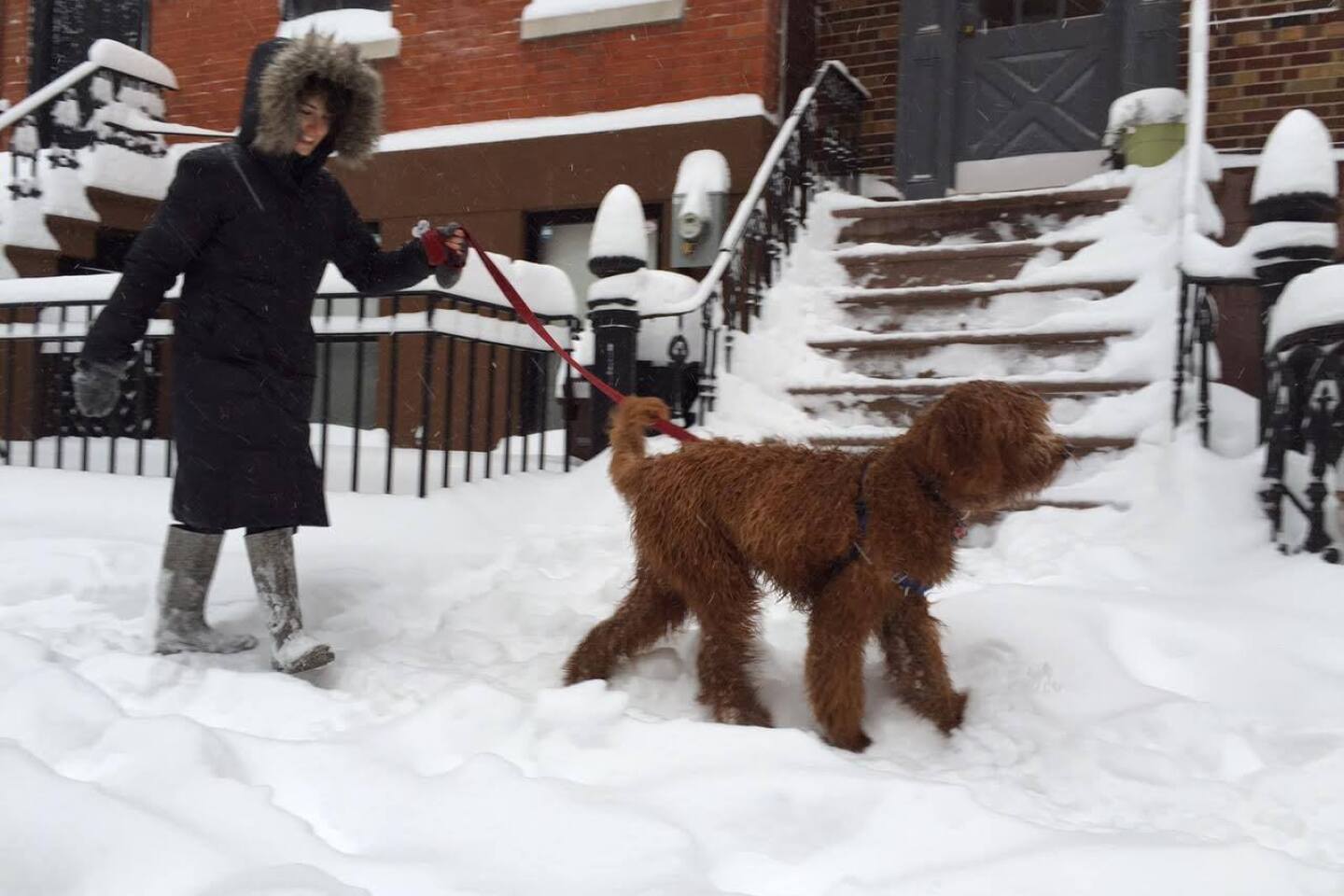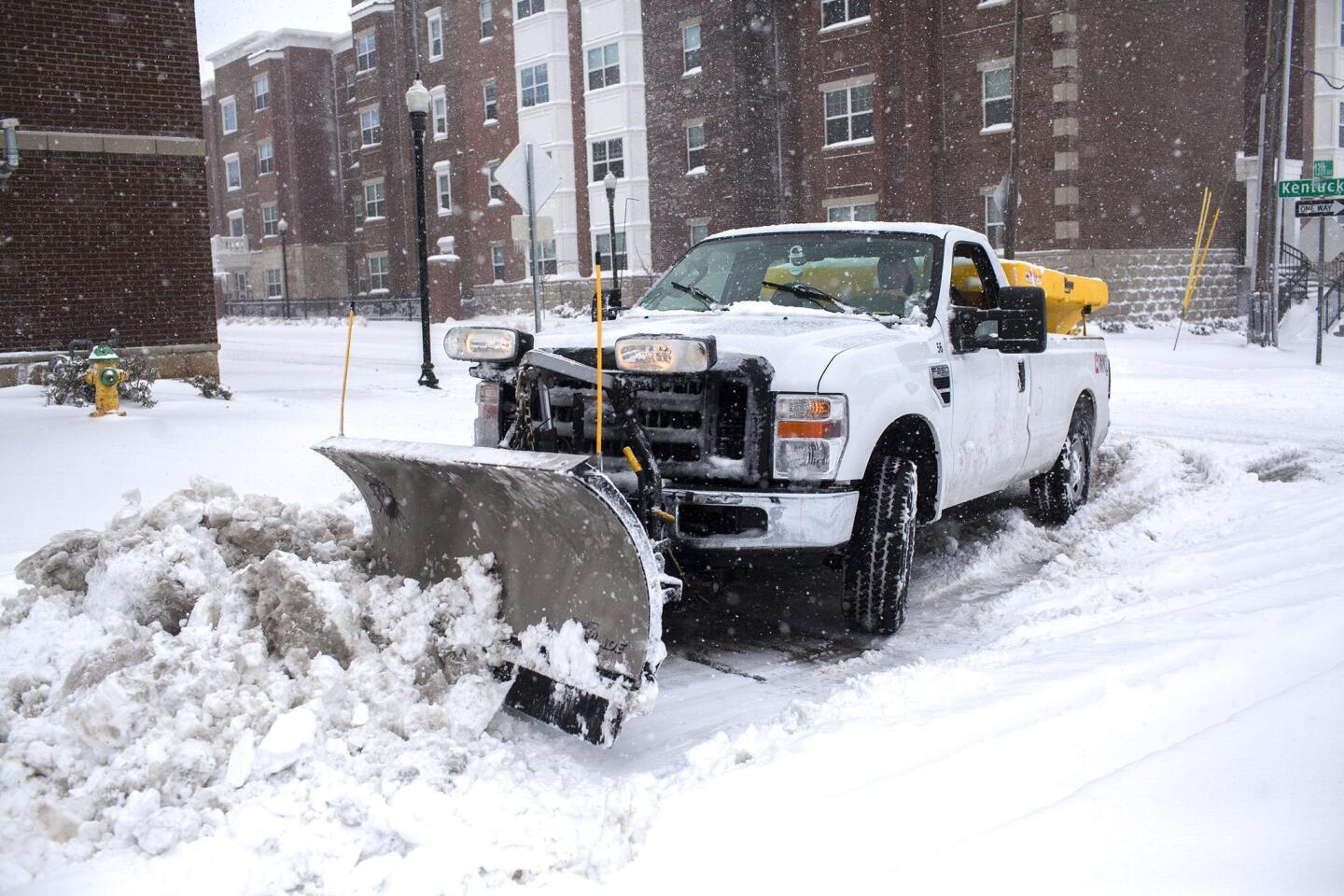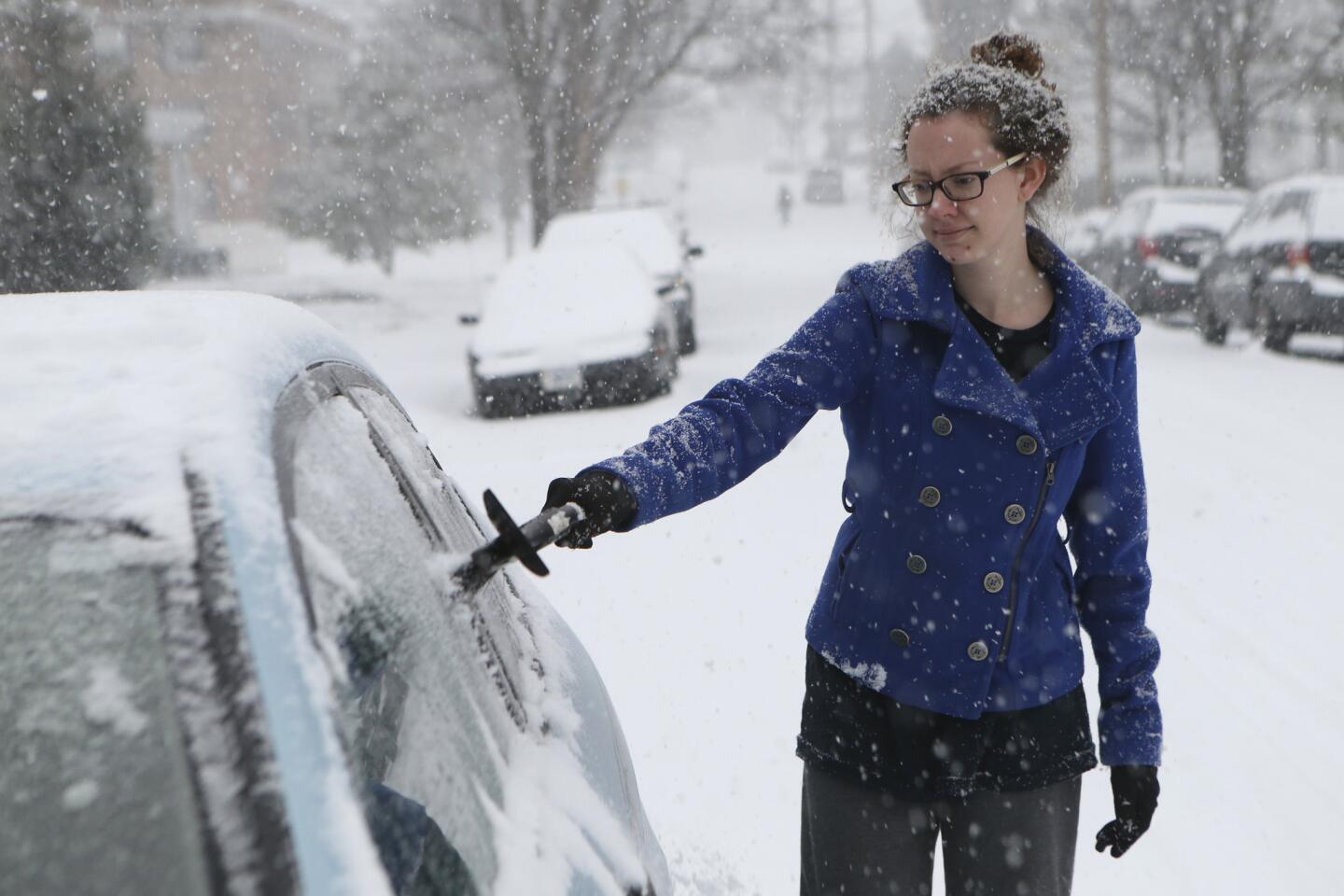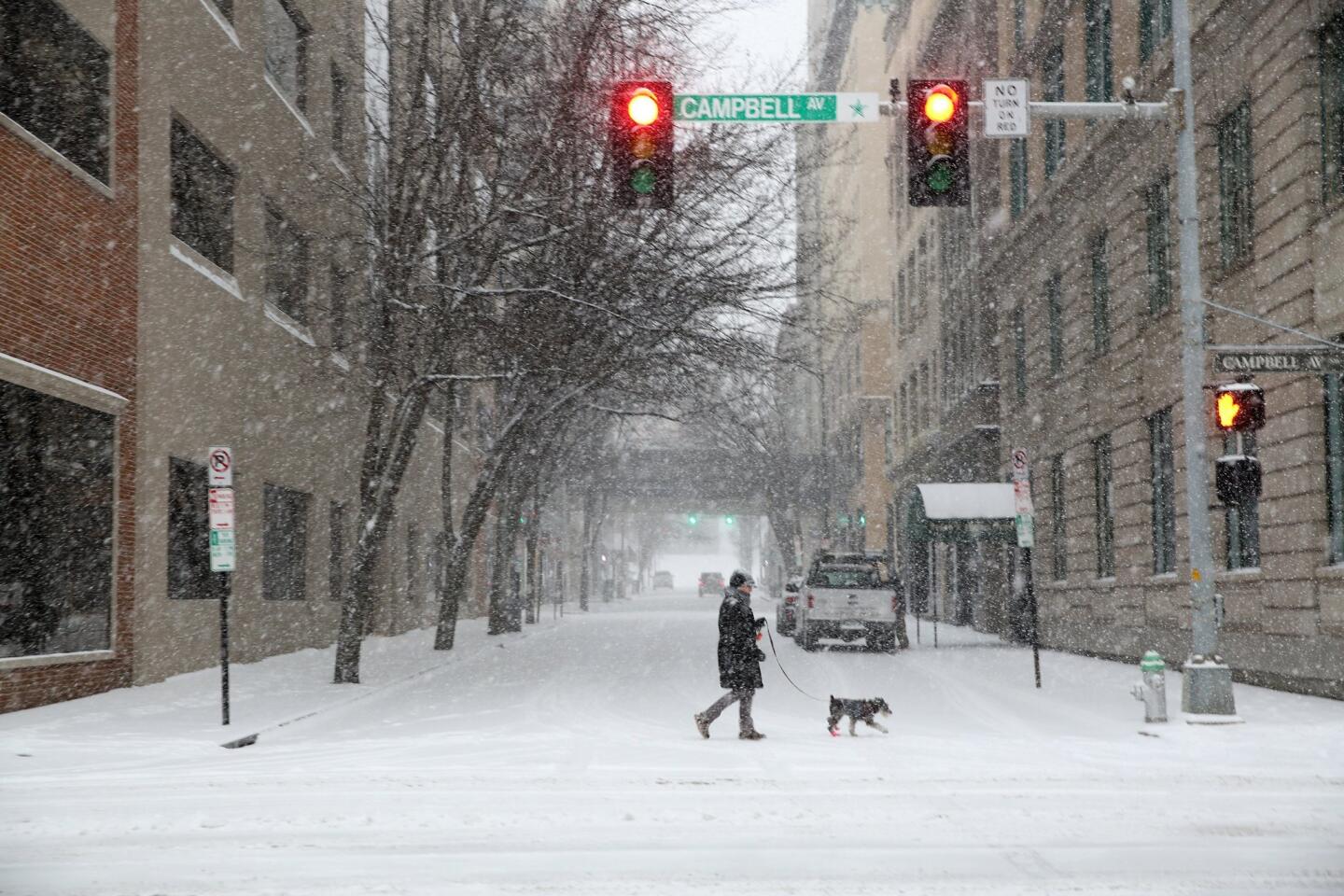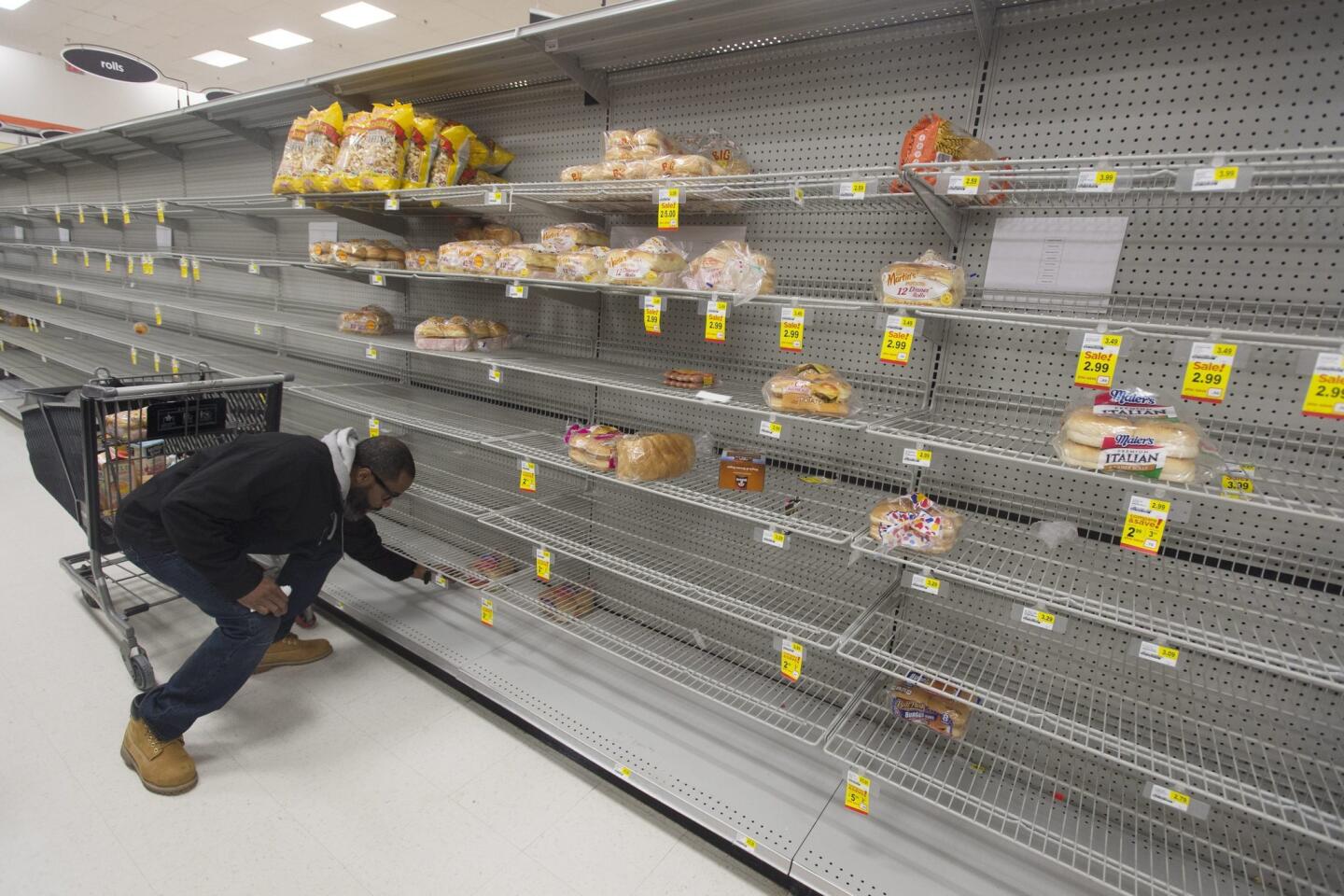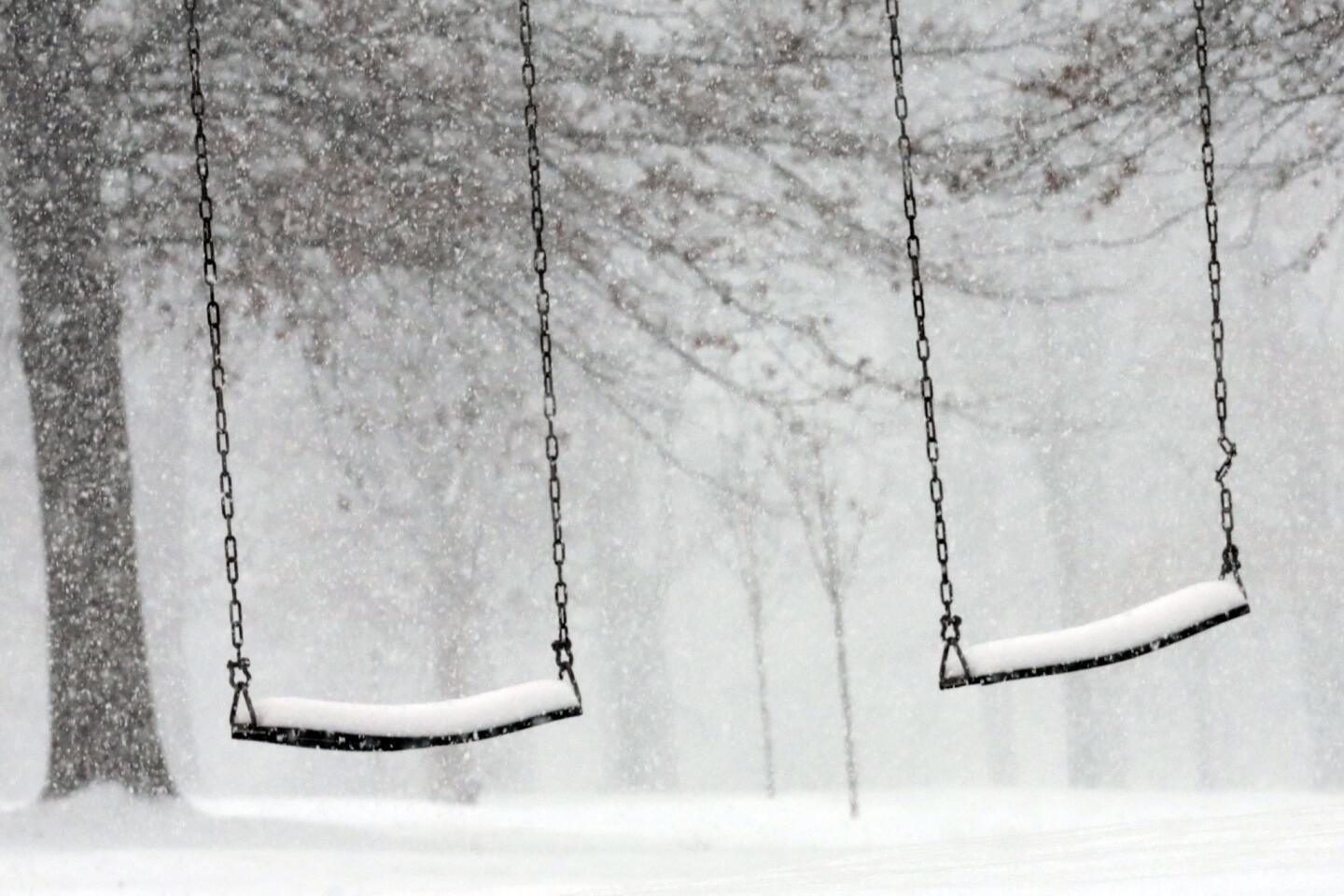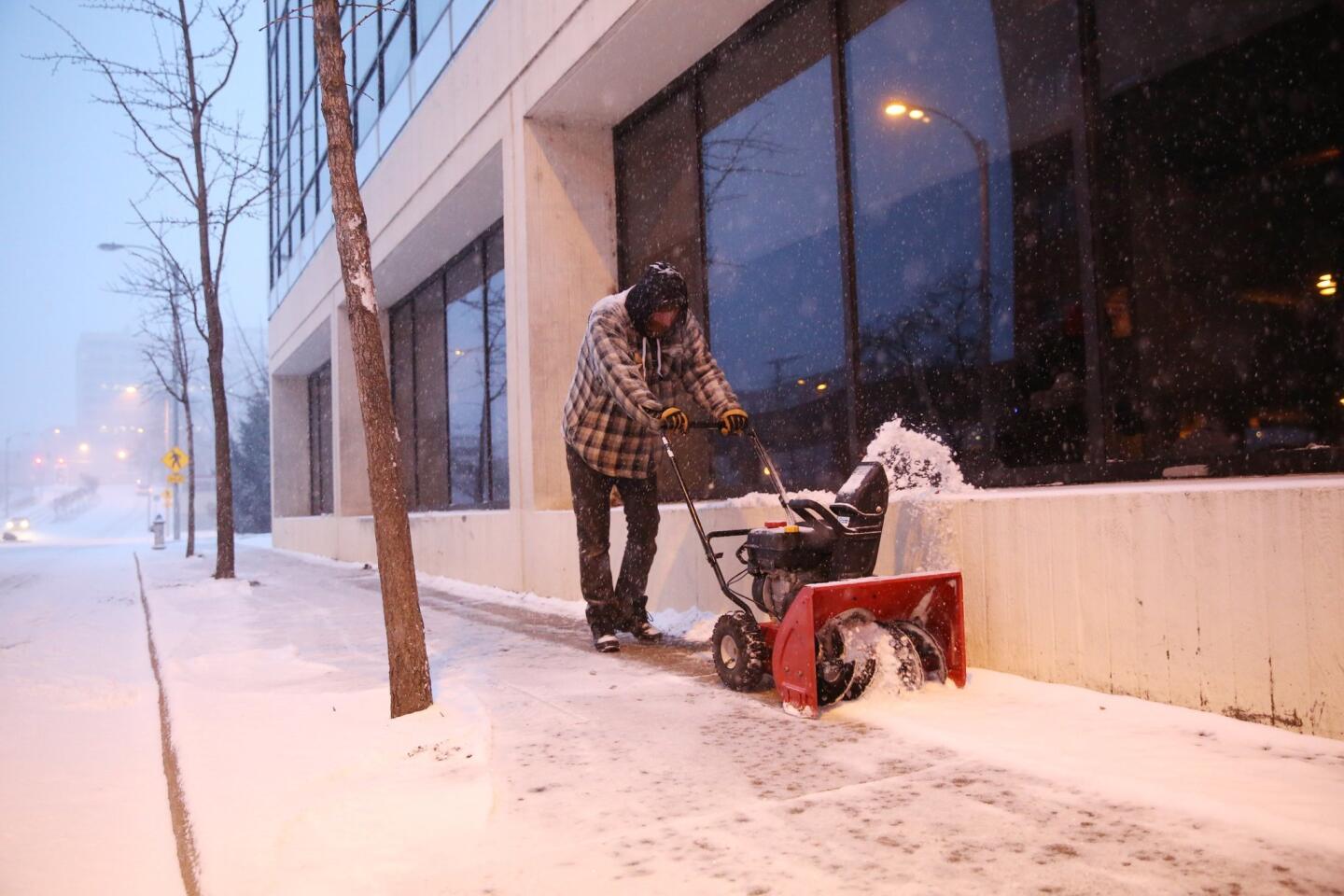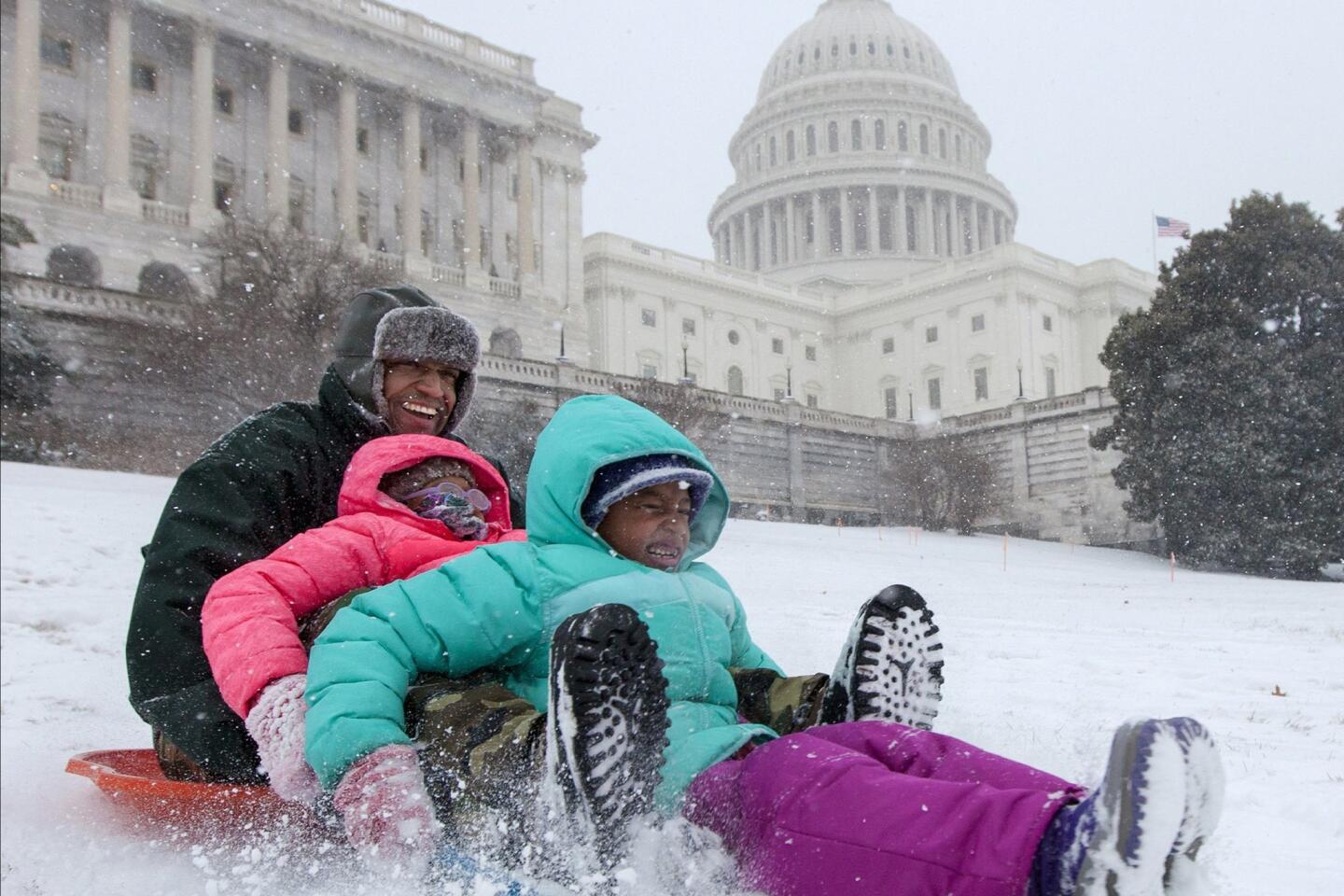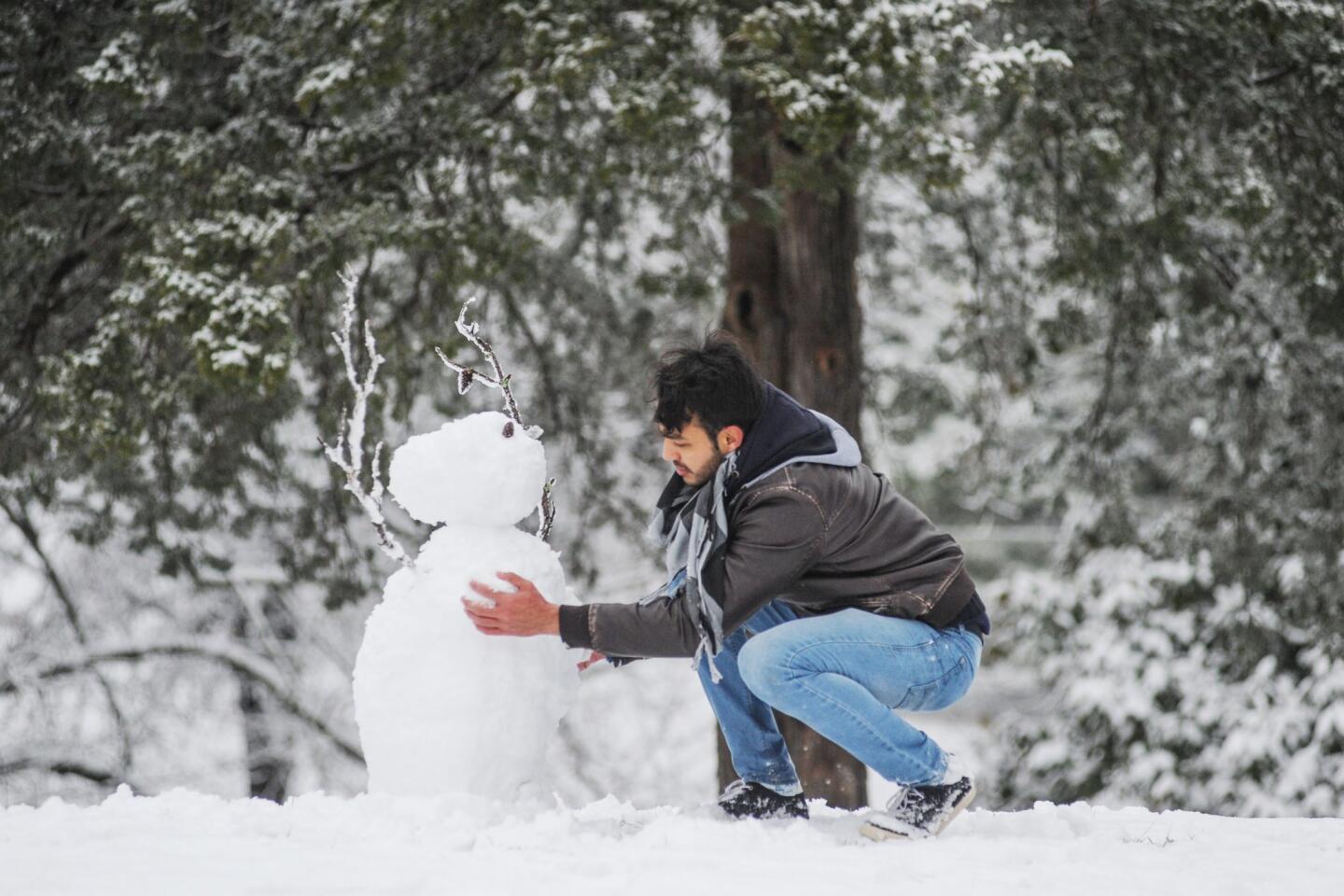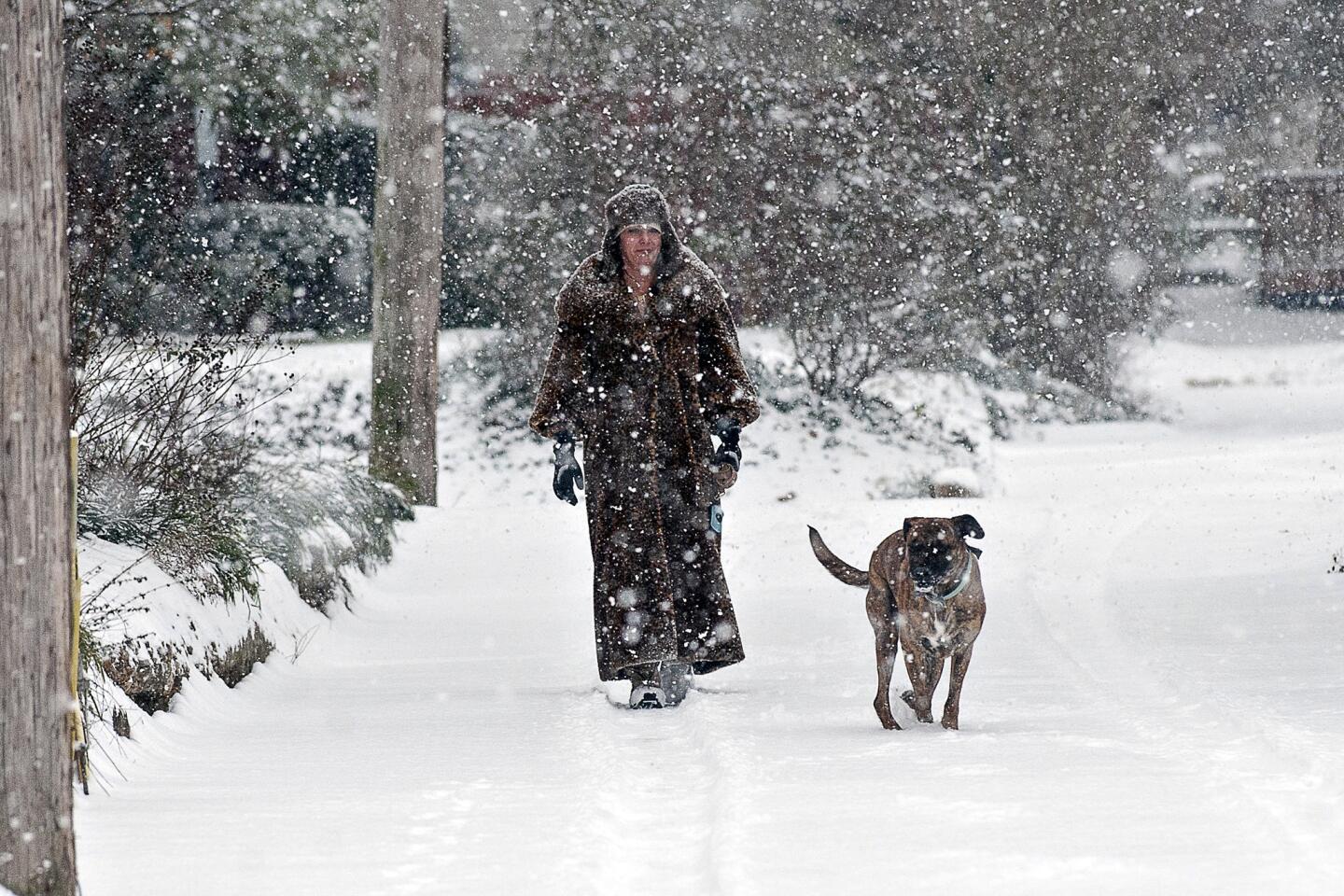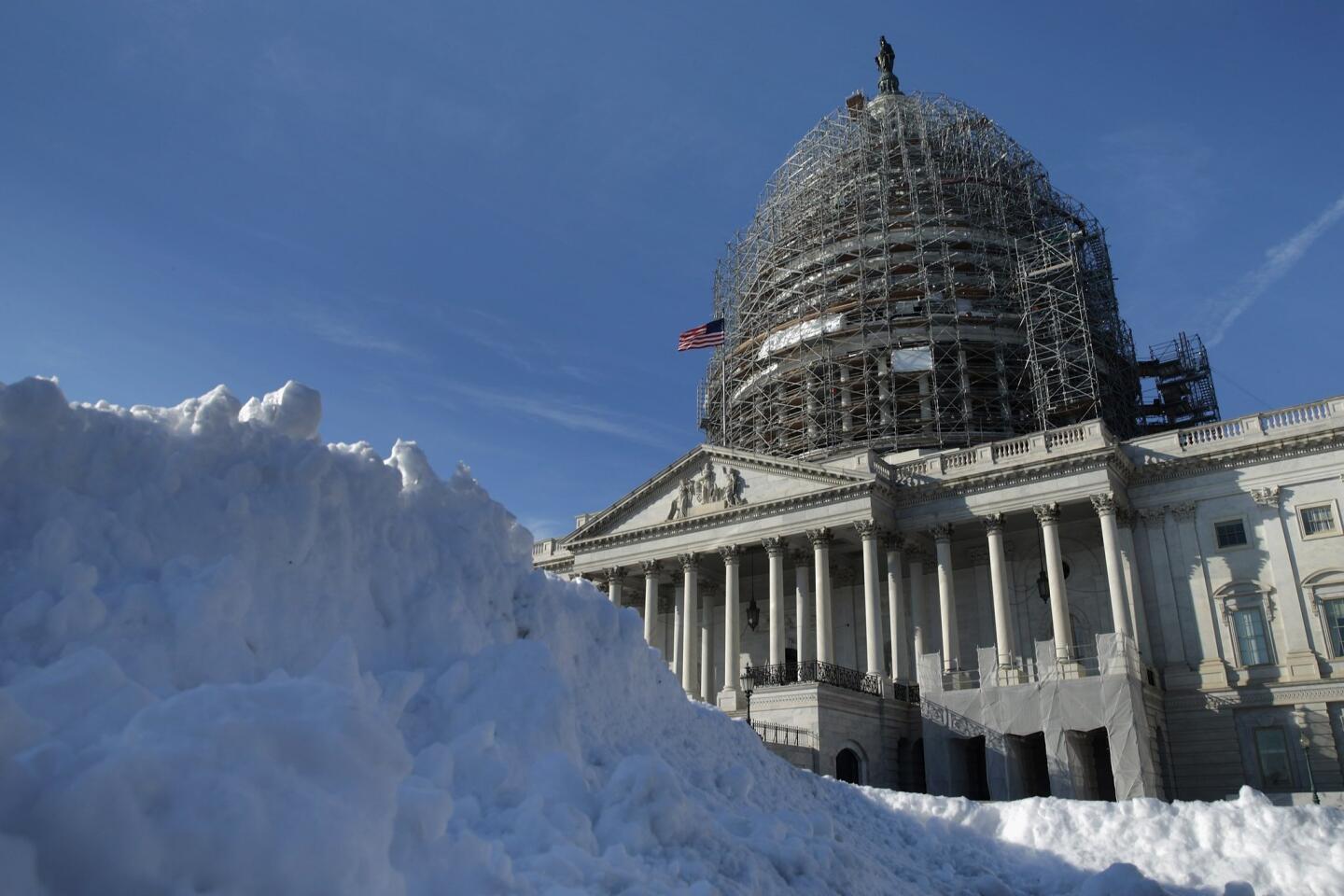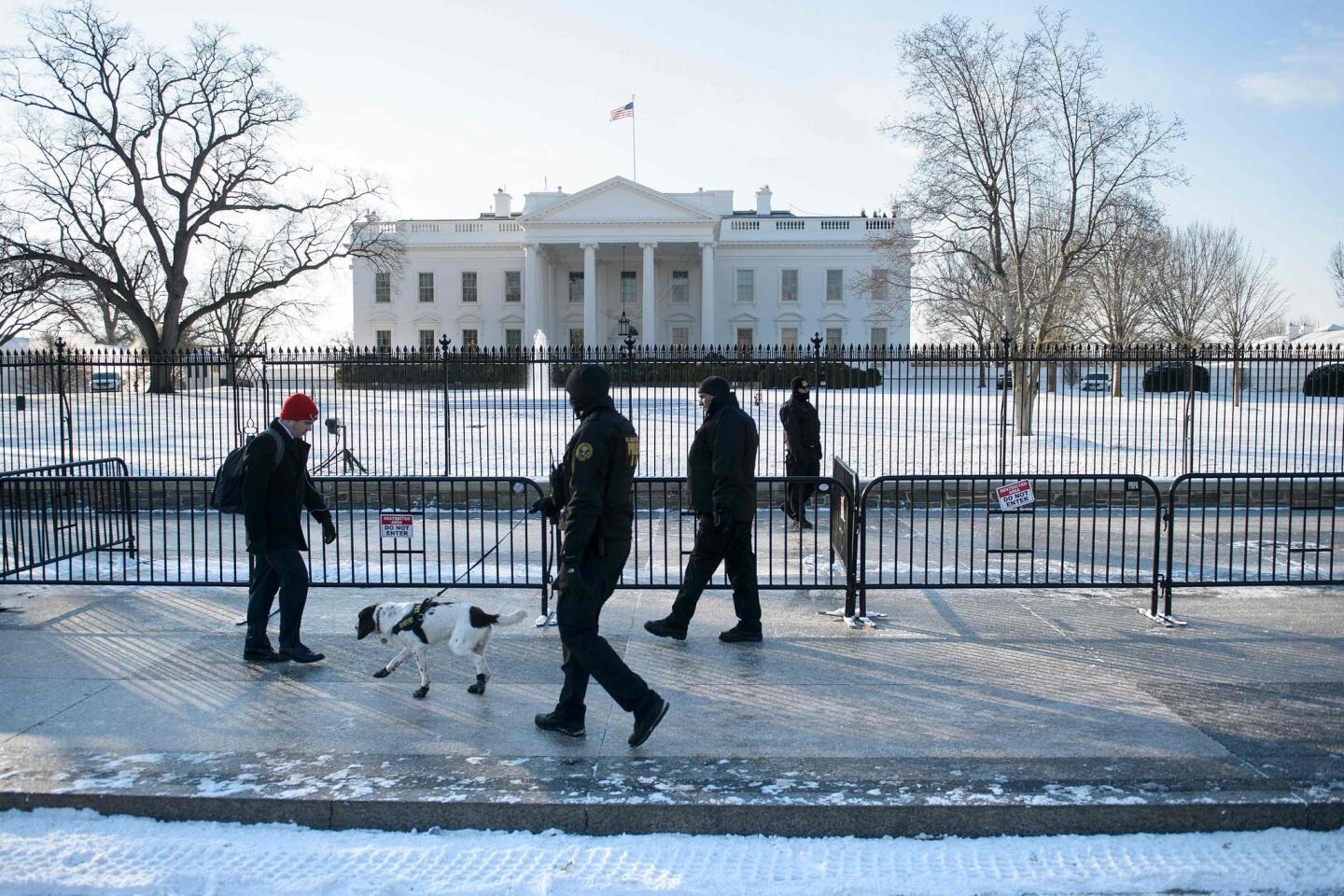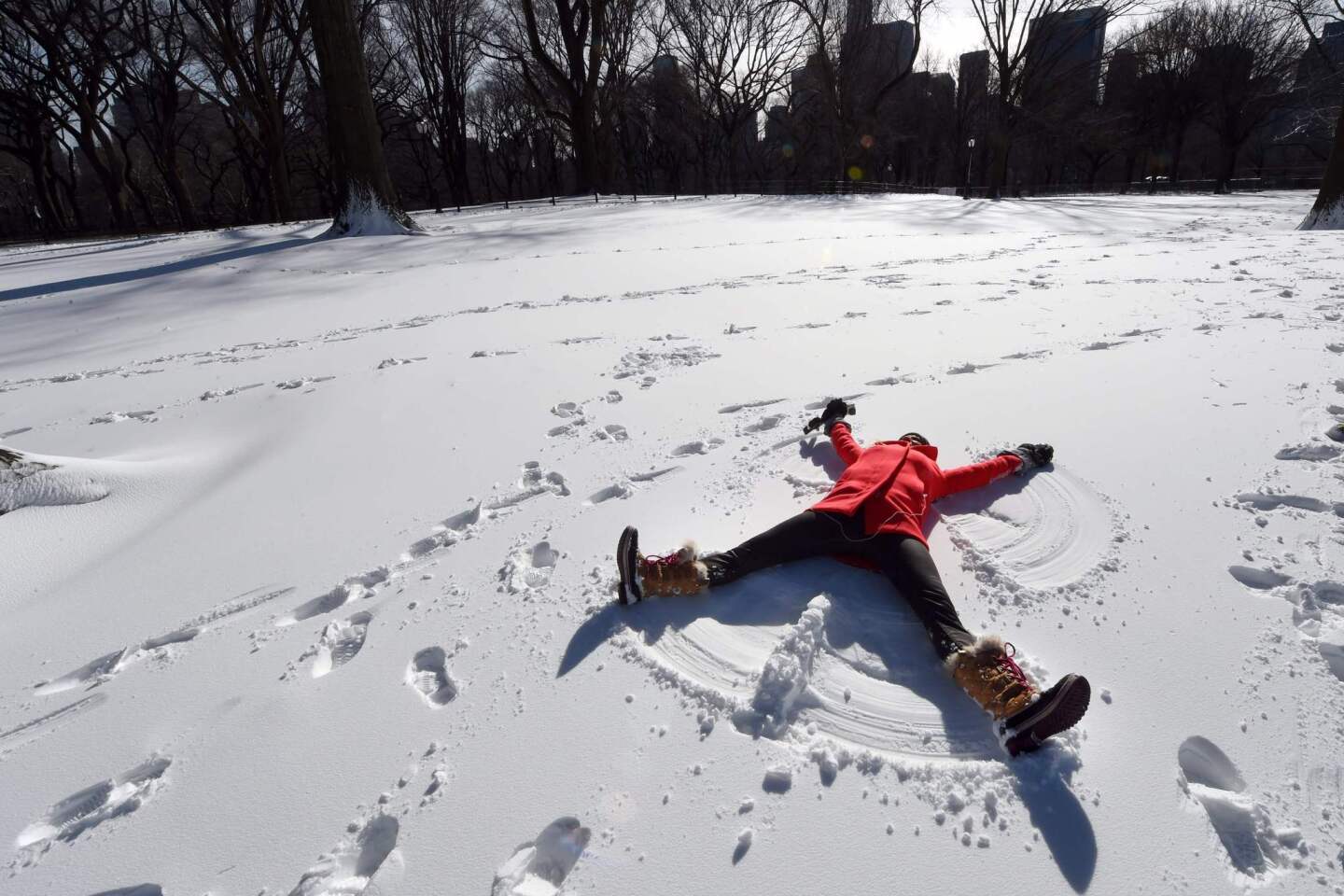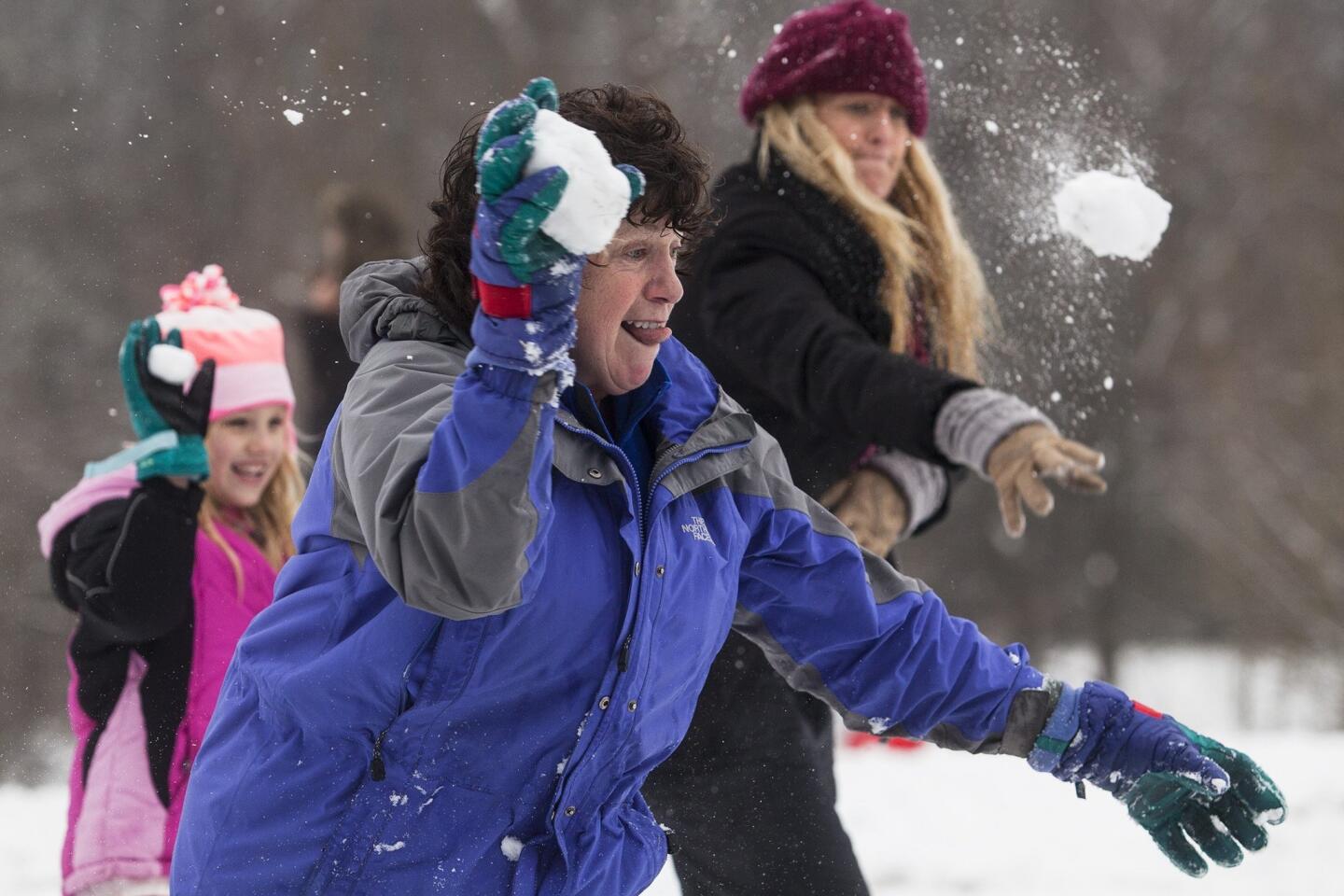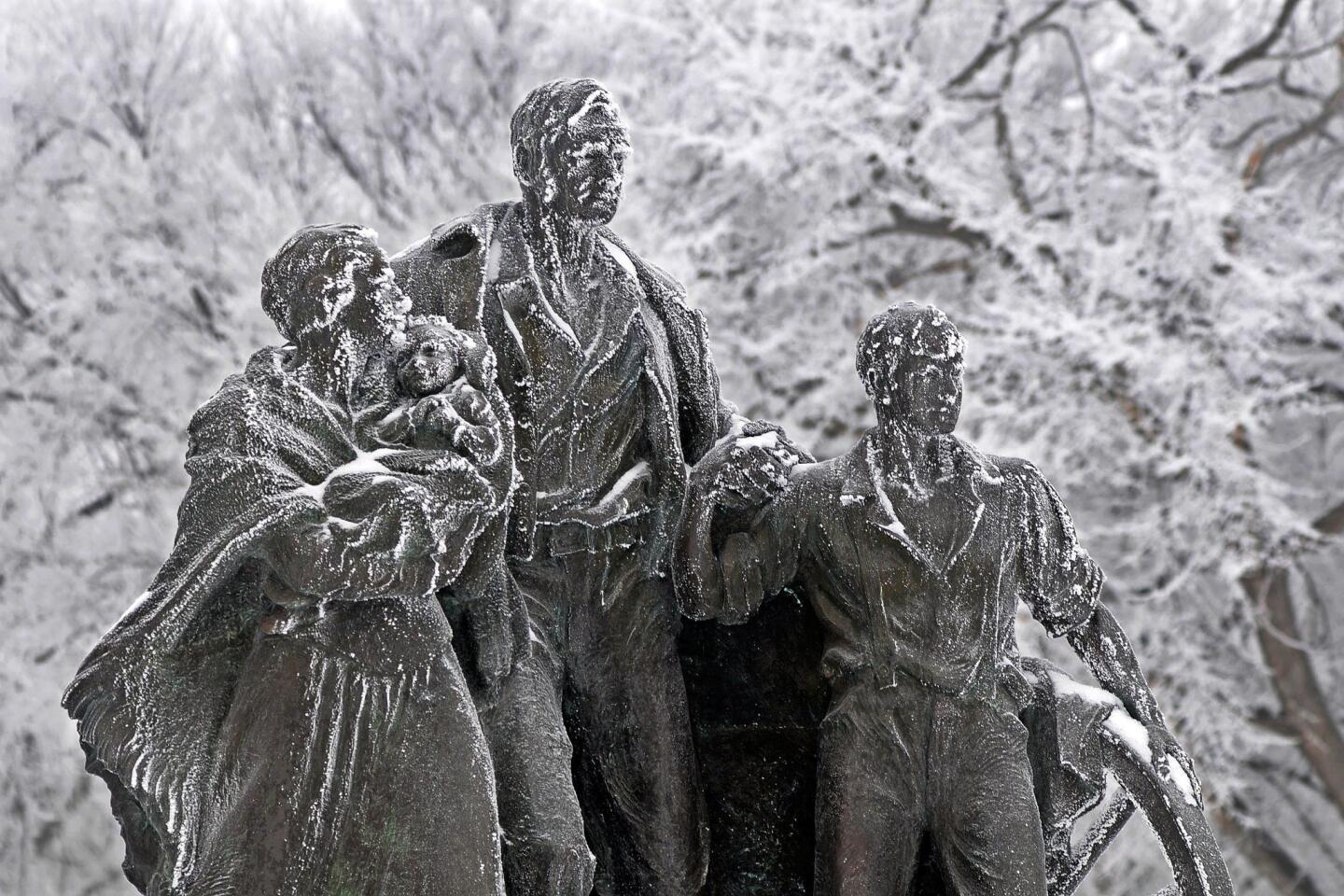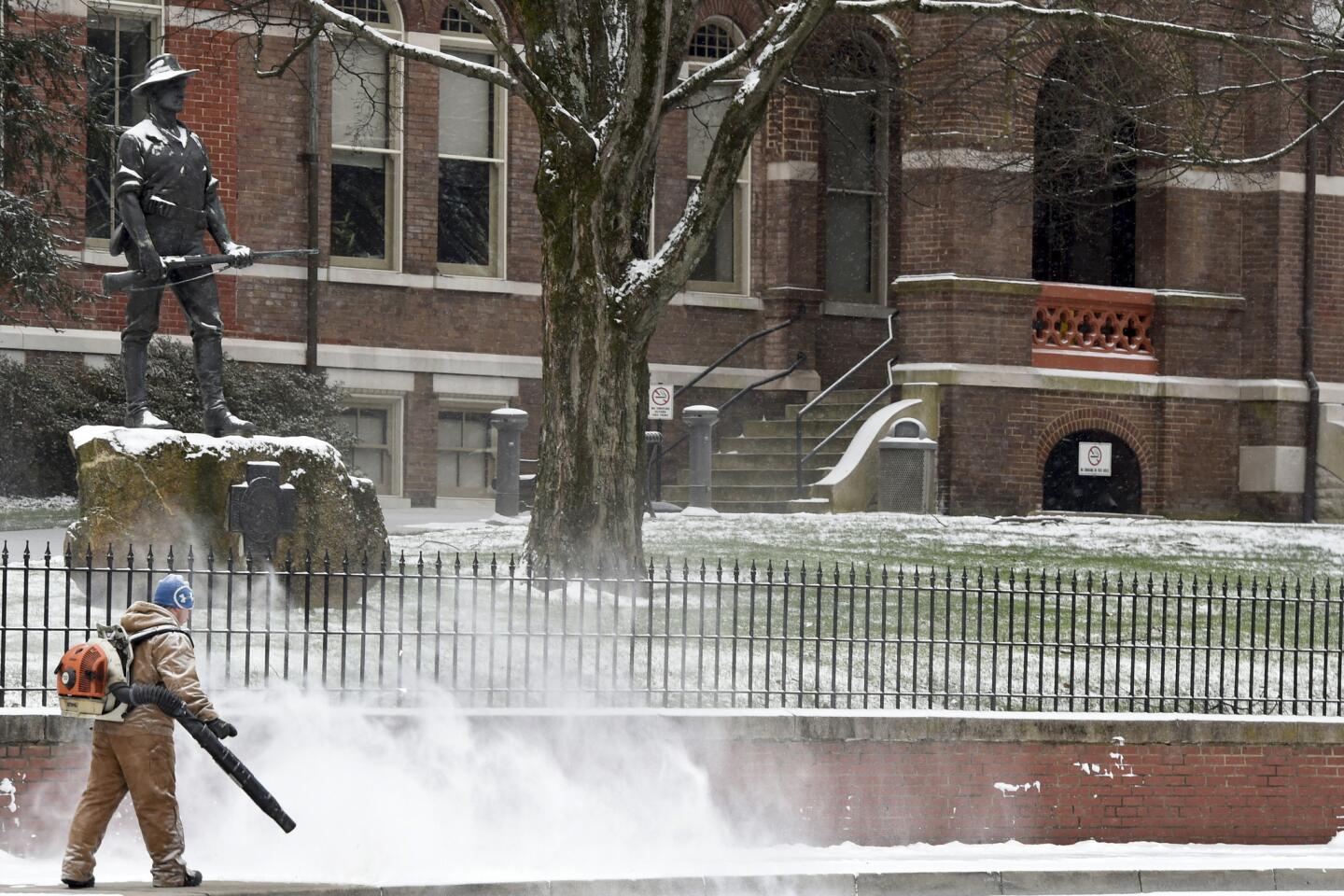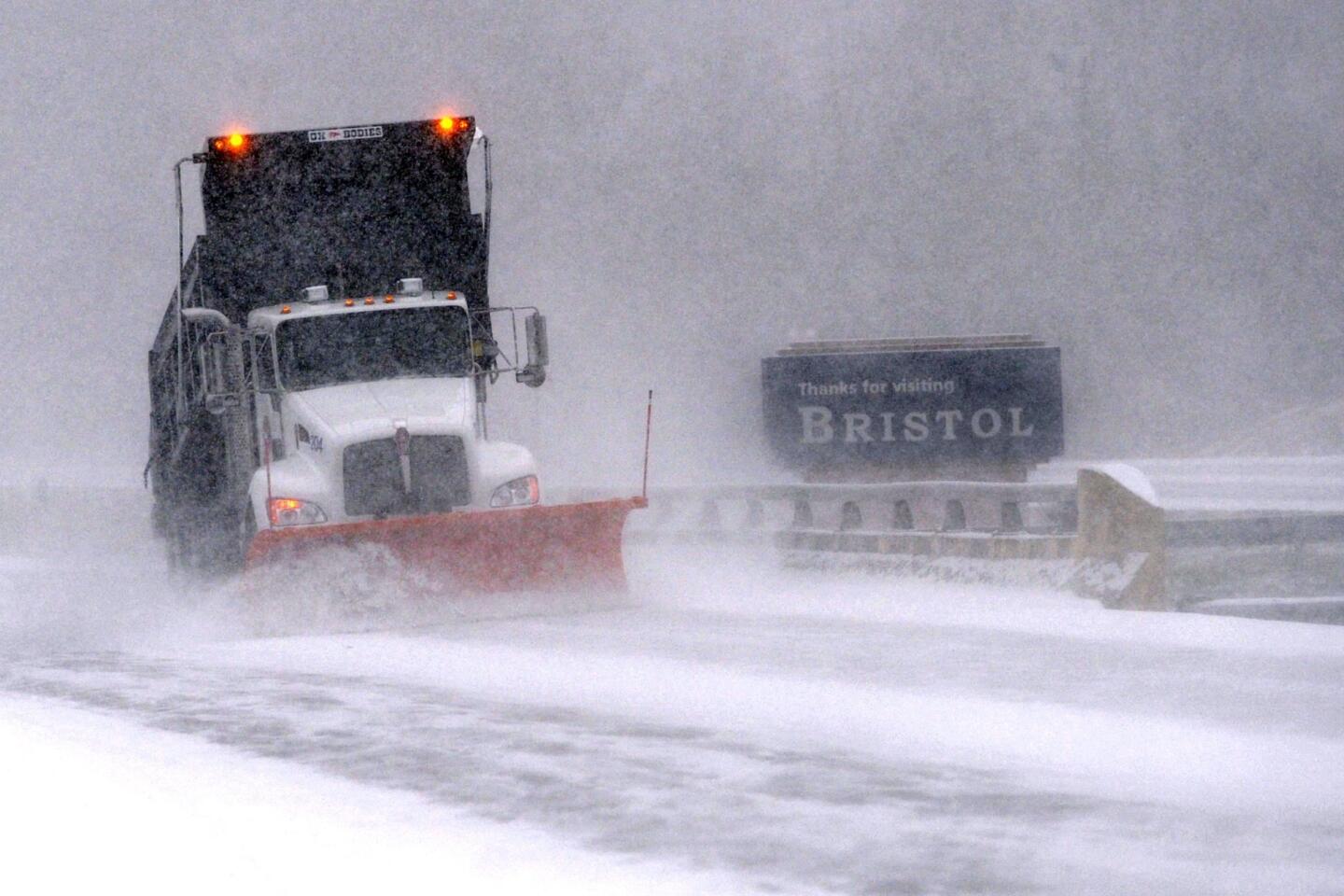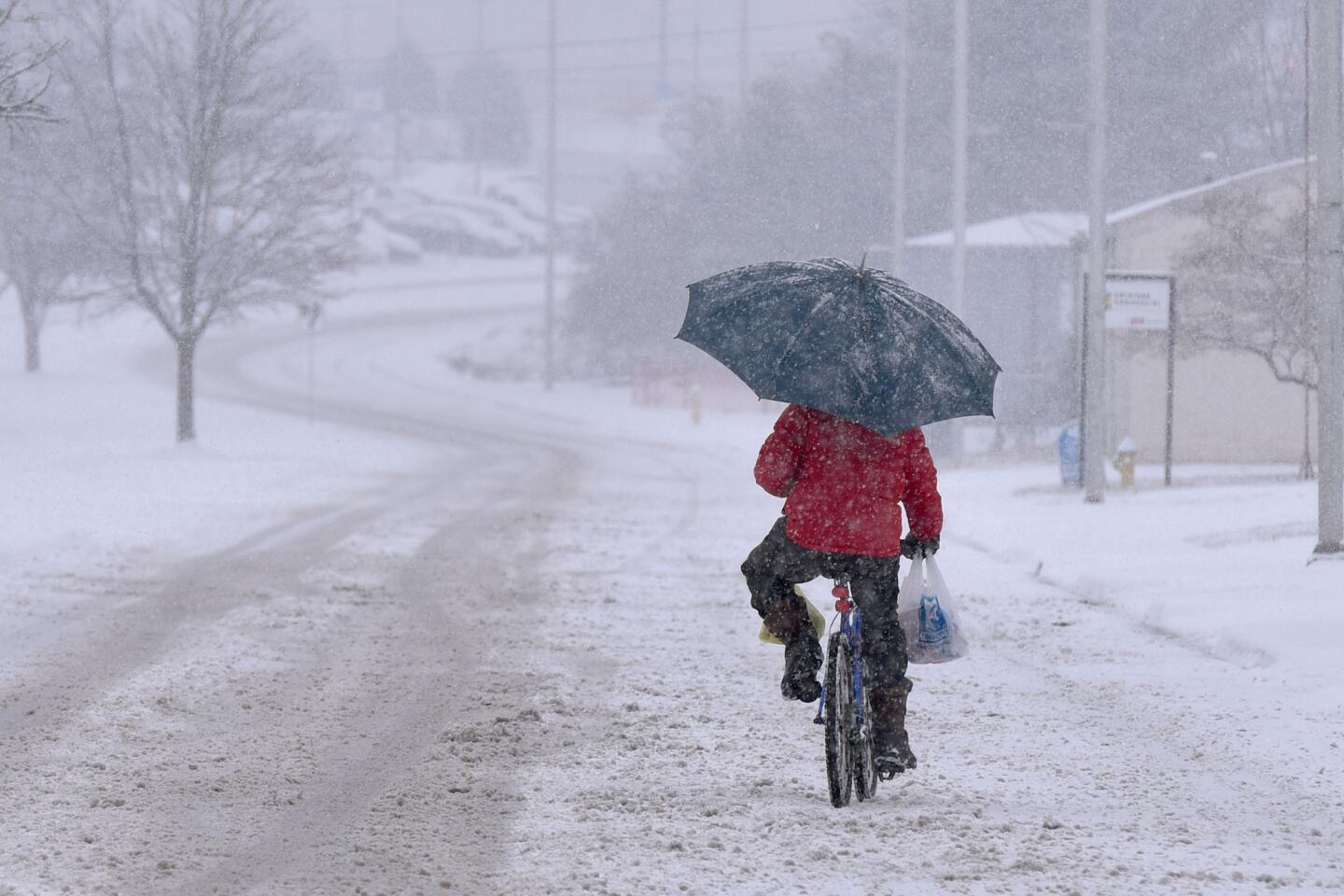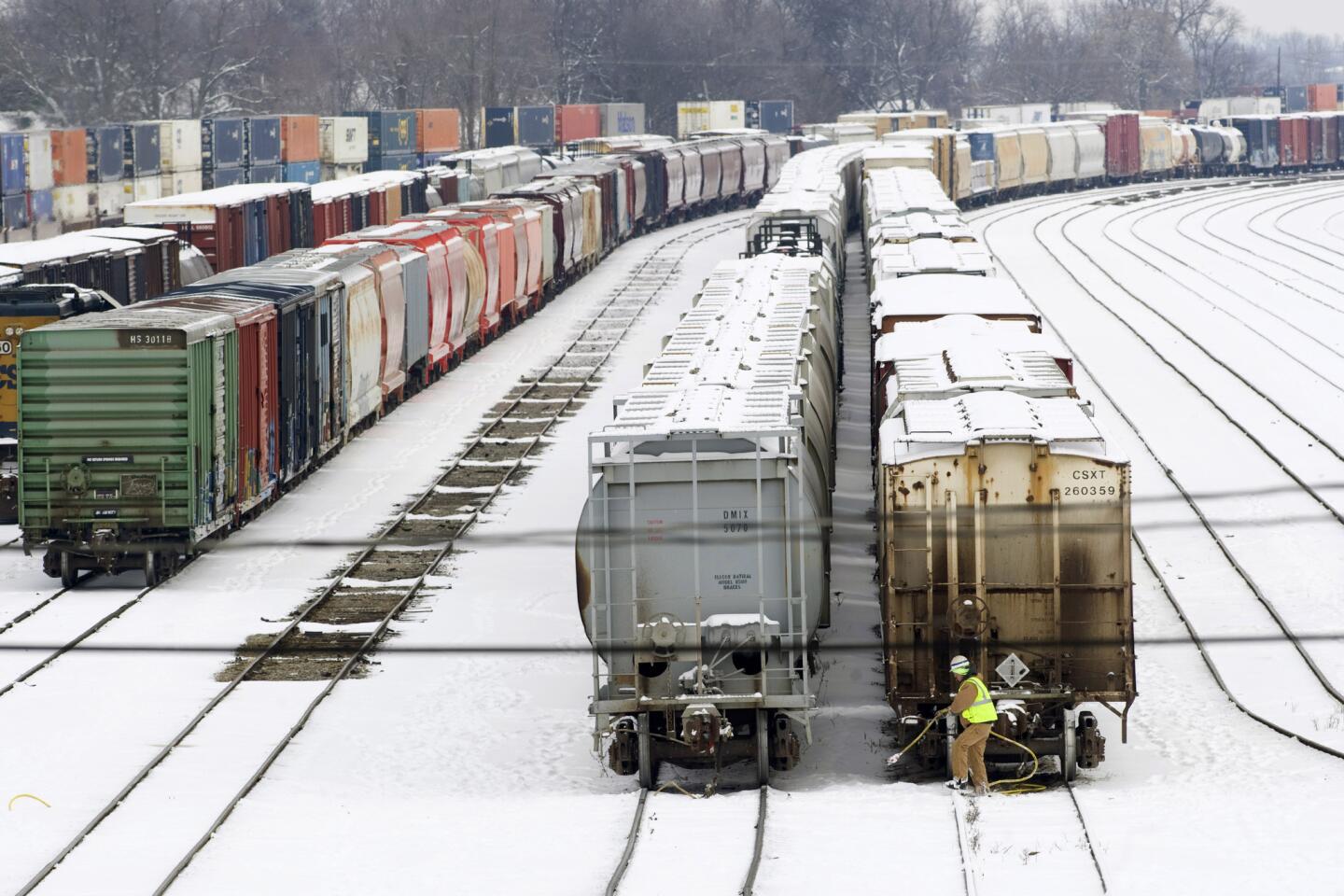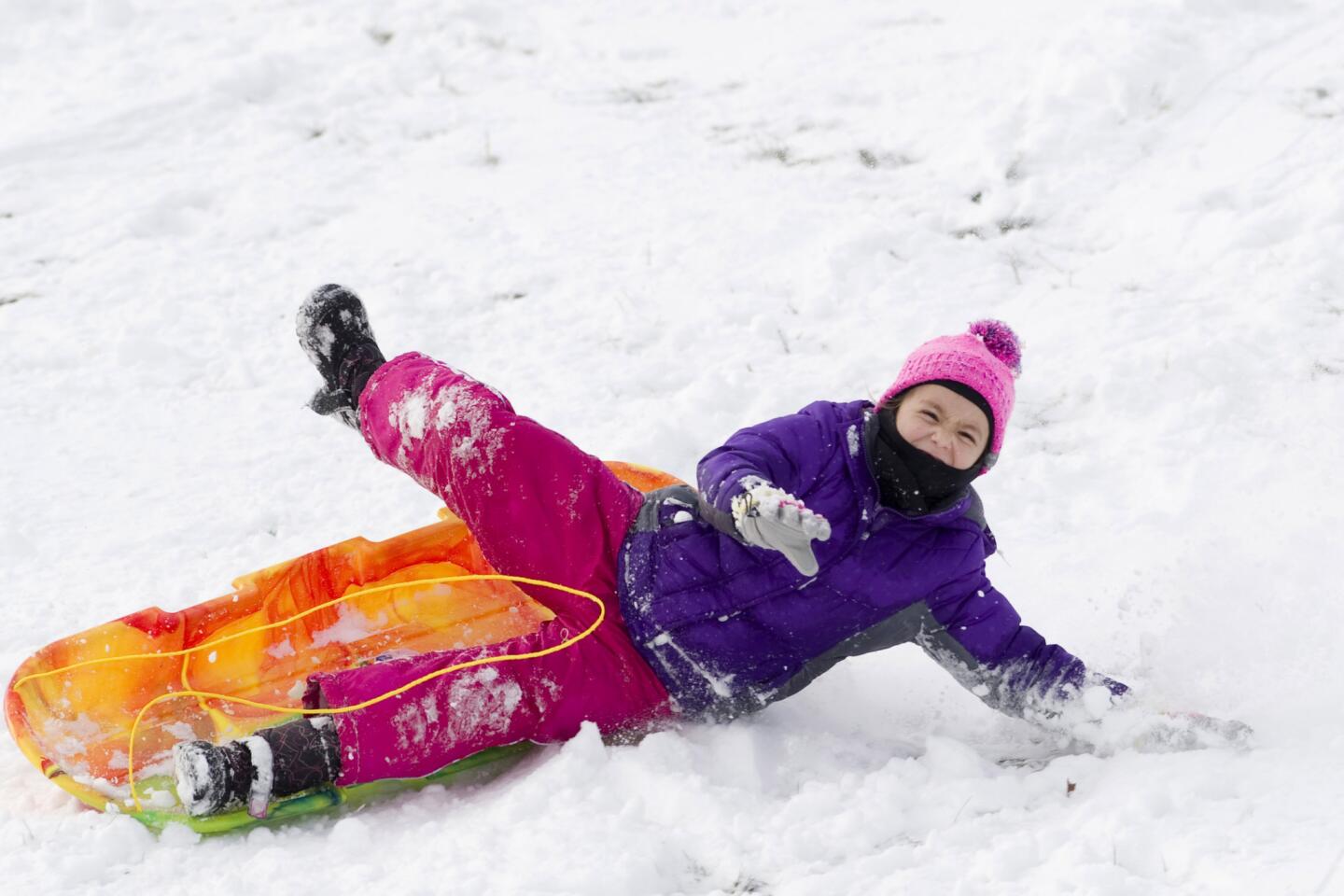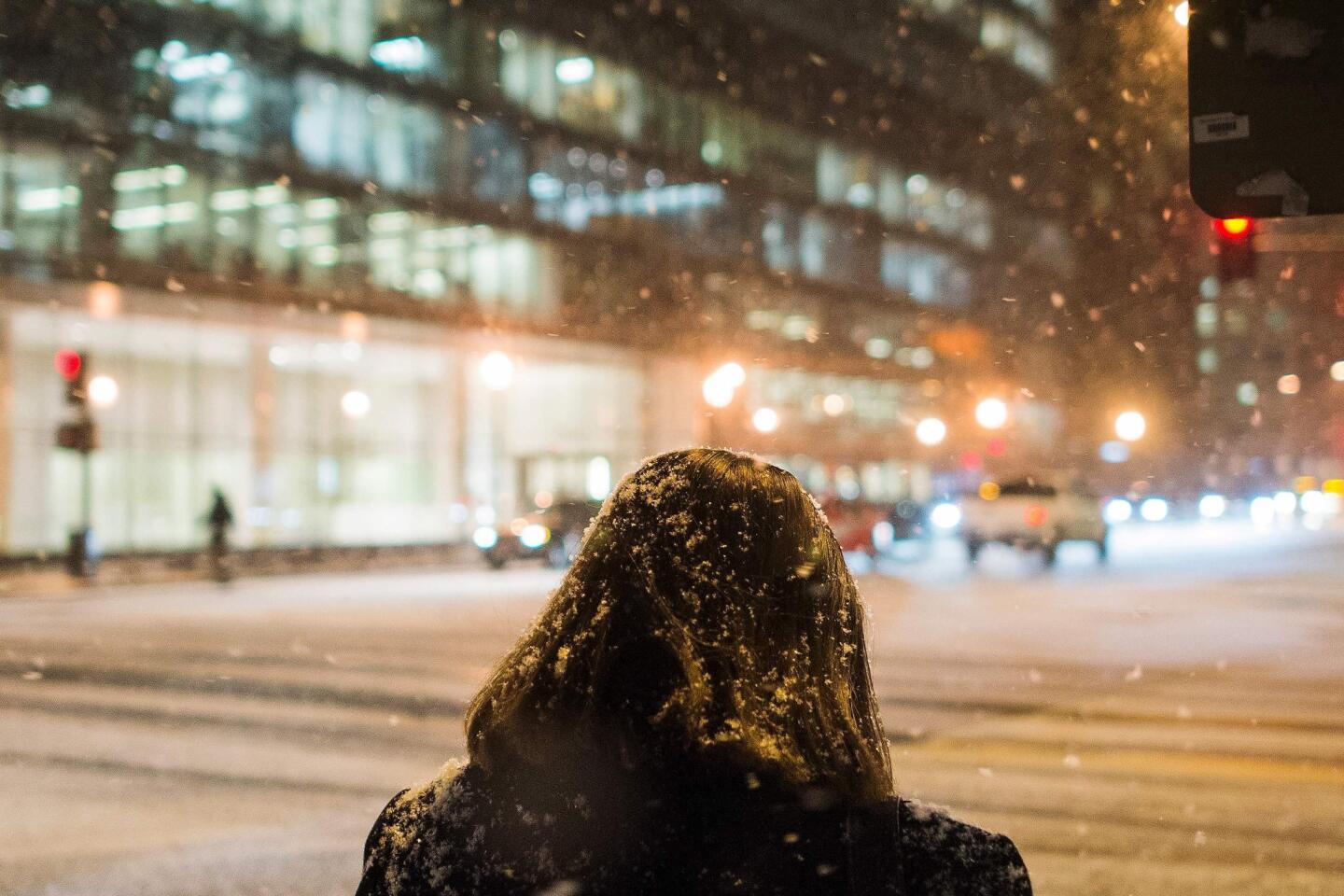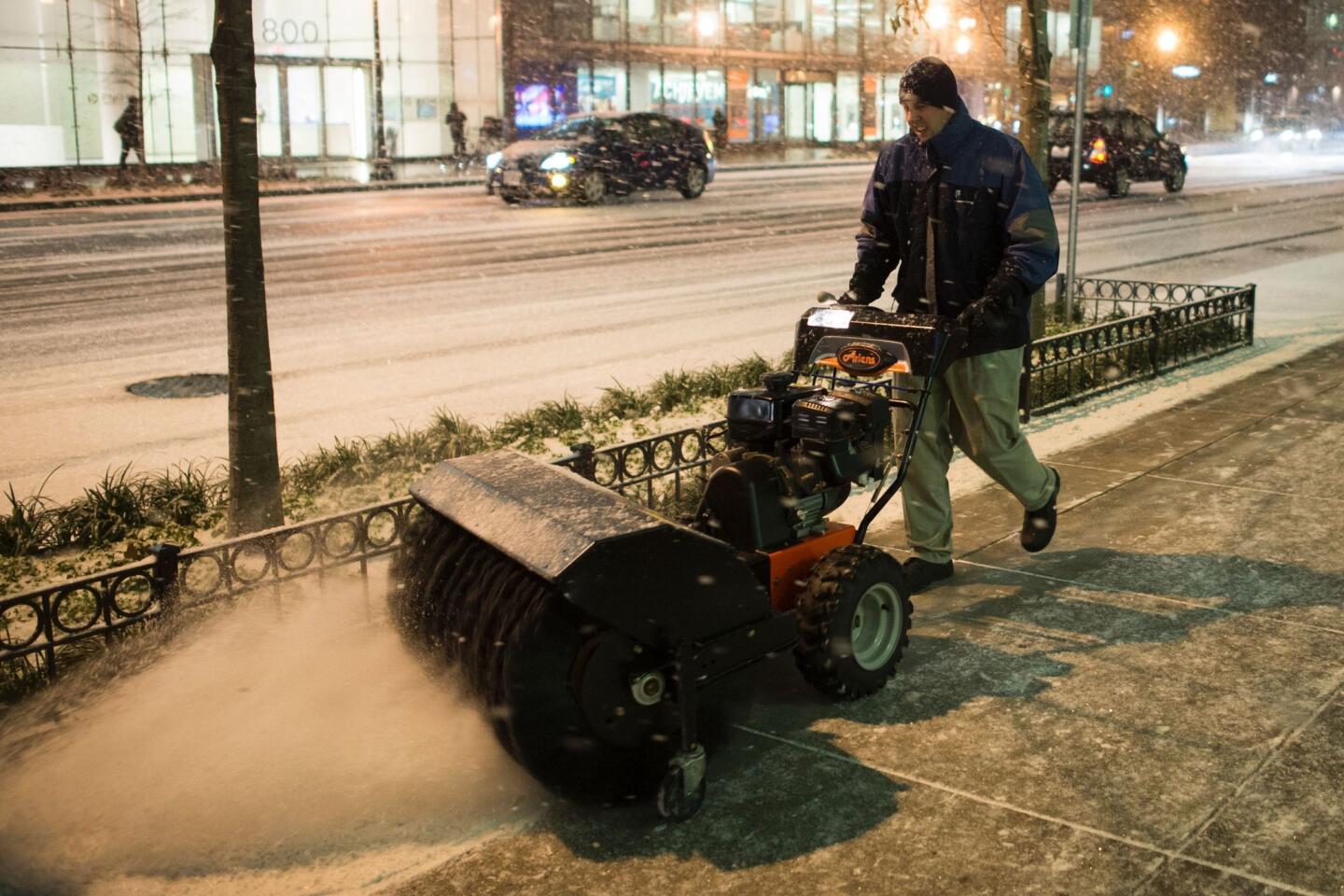Storm brings heavy snow, strong winds, flooding to East Coast; at least 18 are killed
Reporting from New York — The powerful blizzard that slammed the East Coast on Saturday quickly surpassed forecasters’ dire predictions, claiming at least 18 lives, flooding coasts, unleashing hurricane-force winds and paralyzing life for residents of at least 20 states from Georgia to Massachusetts.
The storm was well on its way to smashing snowfall records.
Mayors and governors said they did not expect their cities to be back in business until next week.
“Safety is our number one priority – and right now, it is not safe for the general public to travel,” New York Gov. Andrew Cuomo warned as the heart of the storm hit his state. Visibility was so low that those walking across the Brooklyn Bridge couldn’t see the East River beneath or the Manhattan skyline soaring above. Since Thursday night, 25 inches had fallen in Central Park, nearing the city’s record of 26.9 inches, which fell over two days in 2006.
Cuomo took the rare step of banning all travel in the nation’s largest city Saturday. Drivers in New York City who failed to stay off the roads risked being ticketed, and even trains and large segments of the subway system, the lifeblood of the city, were shut down. Minutes before imposing the travel ban, Cuomo said, he saw the risk firsthand when he helped a crew rescue a driver whose car had spun out on Long Island’s Cross Island Parkway.
Many who tried to drive through the storm elsewhere soon regretted it, as icy and snow-covered roadways from Kentucky to Pennsylvania stranded motorists for hours behind crashed cars and whiteout conditions.
“We’ve hit the 24 hour mark on the bus!” the Temple University women’s gymnastics team tweeted from the Pennsylvania Turnpike on Saturday afternoon. The athletes watched Disney movies to pass the time, according to their tweets.
Another bus full of college athletes stuck on the same highway, the Duquesne University men’s basketball team, hiked nearly a mile through more than 2 feet of snow to meet a Domino’s driver so they could eat, according to their social media account.
Along New Jersey’s and Delaware’s coastlines, Saturday’s storm caused ice-laden seawater to rush into the streets of beach towns. This same area — a network of low-lying communities, brackish bays and dune-covered oceanfront — was hit hard by Superstorm Sandy in 2012.
“The barrier islands here are very narrow, so it’s usually the bay that breaches,” said Chip French, an Avalon, N.J., resident whose town sits on a narrow stretch of land alongside the Atlantic Ocean. “We have ice floes going down the streets of the barrier islands right now.”
The snow was being whipped by winds that reached 75 mph at Dewey Beach in Delaware and Langley Air Force Base in Virginia, according to the National Weather Service.
Across the region, the snowfall totals from Thursday to Saturday were staggering. Twenty inches in Philadelphia. Several Maryland communities saw 35 inches—or more. At the National Zoo in Washington, 22 inches were recorded. In Glengary, W.Va., an amateur radio operator reported 40 inches.
More than 10,000 flights around the country were canceled between Friday and Sunday, most of them due to the storm, according to FlightAware.com, which tracks airline service. Tens of thousands of homes were without electricity.
Officials reported hundreds of traffic accidents and several fires. Cuomo told CNN that his greatest fear was flooding in low-lying parts of the city and on the south shore of Long Island.
“If we’re going to have a real problem, it’s going to be the tidal surge tonight,” he said.
By late afternoon, about 20 inches had been reported in Washington and New York, with little sign of high winds and rising snow levels letting up. Both totals were among the highest ever recorded in those cities.
“I used to like it,” Barbara Enman of Brooklyn said of snow as she shoveled her front steps. “It is pretty, though.”
But also perilous.
“It continues to be a dangerous storm,” Washington Mayor Muriel Bowser warned during a late-afternoon news briefing. Bowser pleaded with residents to sign up online to help the elderly and disabled clear their sidewalks, saying the city had been inundated with calls for help and could not meet the demand.
The Associated Press reported that 18 deaths were attributed to auto accidents, shoveling snow and hypothermia.
Forecasters said the blizzard’s final flakes would probably fall sometime Sunday afternoon in southeastern Massachusetts.
Parked cars up and down the Eastern Seaboard were buried and barely visible under the blankets of white. Normally bustling streets in New York, Philadelphia and Washington were quiet, with occasional sledders and sightseers, but few businesses open for a night on the town.
“It’s a once-in-a-lifetime experience,” said Paul Mikula, who hauled his snowboard up to Times Square in New York and shredded the snow under the neon lights.
Most small shops along that stretch of Broadway, which normally would have been open for steady weekend trade, had closed by about 2 p.m. Remaining open and doing brisk business were several bars and restaurants and a hardware store, where a woman exited with her young daughter and a brand-new sled.
Families coming out of subway tunnels carrying sledding saucers were hit by wind and snow as they tried to make their way to Central Park, where visibility at times was zero.
Across the region, streets remained vacant except for snowplows, which tried, often in vain, to keep up with the relentless outpouring.
“There are very few roads where we’re seeing pavement right now,” said Chris Geldart, the emergency management director for the District of Columbia.
Some saw more extensive flooding. The National Weather Service reported near-record flooding along Delaware’s coast.
Earlier in the day, New Jersey Gov. Chris Christie told reporters that he had directed state resources in the state’s southern region toward communities like Avalon, to ensure that anyone displaced by the flooding had a place to go.
But Christie, who had to cancel presidential campaign events in New Hampshire to return home, said the state had learned from Sandy. In the years after the storm, it purchased and demolished hundreds of unsafe properties along the coastline.
Throughout the storm’s path, there was danger that as the snow got heavier overnight, roofs and trees could falter. And as residents began to shovel, those with heart conditions could be at risk.
Rick Hoffman of Frederick, Md., had worked through the night plowing a small corner of Montgomery County with his blue Ford pickup truck. He was still at it midday Saturday, but couldn’t keep up with the continuous pelting of snow.
“It’s one of the worst I’ve seen,” said the 57-year-old Hoffman, who has worked as a snow-removal contractor for decades. What made things particularly treacherous, he said, was that the light texture of the snow coming down produced a sheath of ice underneath.
“A lot of people underestimated how bad it would be,” he said.
In Gaithersburg, a Maryland suburb north of Washington, Mark Hesseloff was up early Saturday, his 47th birthday, digging an 8-by-6 clearing outside his snow-covered apartment complex. His face was drenched with a mixture of sweat and ice as he scooped sections of snow with his orange shovel.
“This will be a perfect little spot for them,” he said referring to his two bulldogs, who had had been cooped up since Friday afternoon. Moments later, one of them, 8-year-old Blondie, hobbled outside, relieved. “Yup, she’s been waiting,” he said.
Times staff writer Bierman reported from Washington and special correspondent Hansen from New York. Staff writers Don Lee, Lisa Mascaro, Michael Memoli and Sarah Wire and special correspondent Christine Rushton contributed to this report from Washington.
Follow @Noahbierman on Twitter
ALSO
LAX flights delayed or canceled due to East Coast storms
In Iowa farm town, immigration debate yields surprising views
A ‘man-made disaster’ unfolded in Flint, within plain sight of water regulators
More to Read
Sign up for Essential California
The most important California stories and recommendations in your inbox every morning.
You may occasionally receive promotional content from the Los Angeles Times.
